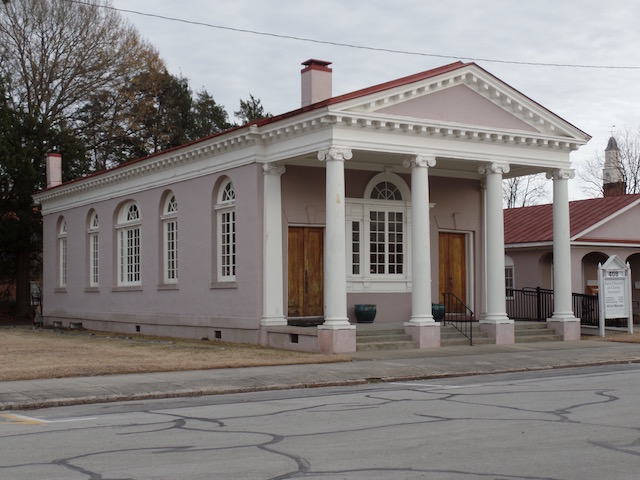Susan's Blog - New Bern Valentines Day 2016 (Day 2)
Valentines Day itself, we woke up fairly late and had a great breakfast at the B&B. This is definitely one of the reasons to stay at a B&B .. the breakfasts are really good! They start with a breakfast appetizer, like a blueberry or strawberry cobbler-type starter and then you have your choice of 3 main breakfasts. One is a large omelet (different spices each day) along with things like pancakes and french toast. A side of meat (sausage or bacon, depending on the day), fruit, and then coffee, tea, and juice.
Then we headed out for a walk (although it was frigid and so the walk was cut short!) Across the street from the John Wright Stanly home (that we'll see later along with the Tryon Palace), is the Amelia Green house. There is an interesting story here. John Carruthers Stanly was the illegitimate son of John Wright Stanly (a prominent merchant-shipper) and an Ebo slave. So he was born a slave in 1774, although he seemed to have been raised not like the slaves that you see in the movies. He apprenticed with some close friends and neighbors of his father, who ensured that he received an education and learned the trade of barbering. He opened his own barbershop and many of the town's farmers and planters frequented his barbershop for a shave or a trim, making his little busines quite successful.
By the time he was 21, he was literate and economically able to provide for himself. His owners petitioned the Craven County court in 1795 and in 1798 he was emancipated, gaining the rights and privileges of a free person. He then purchased another slave named Kitty and also worked to have her emancipated. A few days later they were married in a public ceremony, which was unique for blacks at that time. The name Amelia Green house comes from Kitty's grandmother, Amelia Green.
His story isn't specifically a happy-ending one ... he continued to thrive, at one time having 163 slaves himself. However, his wife became seriously ill and died, and about the same time, Stanly began having financial issues. Part of his issues came from the issues of the time but also because he had taken on some debts of his half-brother, John Stanly Jr.
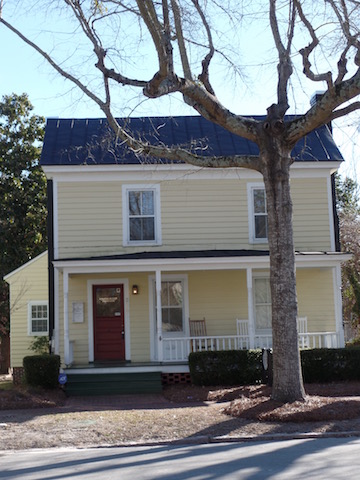
Next was the Major John Daves House on George Street. John Daves was a Revolutionary War officer who was born in Virginia. When he was two years old, his family moved to New Bern and he resided there for the rest of his life. This house was one that he built, largely with his own hands. There are actually 3 cottages here (and it looks like today, these are rentals). In its rear yard is a huge mulberry tree that supposedly was planted by Baron Christopher deGraffenried who reportedly imported silkworms and attempted to start a silk industry. As a soldier of the first Continental line troops, Daves was appointed quartermaster of the Second Regiment, aided in the repulse of Lord Dunmore in December 1775 at Norfolk, Va., and helped defeat the British the next June at Sullivan's Island. Commissioned an ensign 30 Sept. 1776, he was ordered to join General George Washington's forces, with which he served bravely at Brandywine, Germantown, Valley Forge, Eutaw Springs, and Monmouth. Following duty at Morristown and in the New York highlands, he was wounded in 1779 at Stony Point and was promoted to Captain in September 1781. After the war, Daves was a major of the North Carolina state troops and was one of the original 60 members of the North Carolina Society of the Cincinnati. On 9 Feb. 1790, President Washington named him the first collector of customs at New Bern, where a customhouse had been opened in March. He became inspector of surveys and ports in 1792. Daves was a warden of Christ Episcopal Church and upon his death, he was buried with military and Masonic honors in Cedar Grove Cemetery, New Bern.
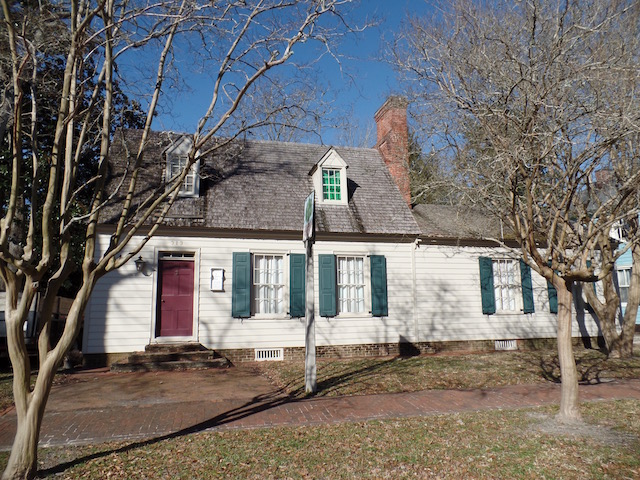
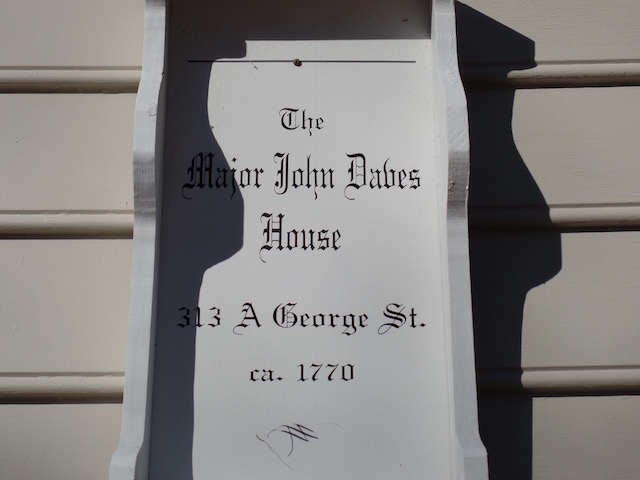
You'll see that today we did more Churches than houses. St. Peter's AME Zion Church is a historic African Methodist Episcopal church. The current building was built between 1923 and 1942 on the site of the 1914 church building which was destroyed by fire in 1922. It is a large three bay by seven bay, rectangular brick church building in the Late Gothic Revival style. It features a gabled nave flanked by two-story truncated stair towers. It is known within the denomination as the "Mother Church of Zion Methodism in the South". While the building only dates back to the 1900's, the congregation has been active in New Bern since 1863 making it the oldest existing African Methodist Episcopal congregation in the South.
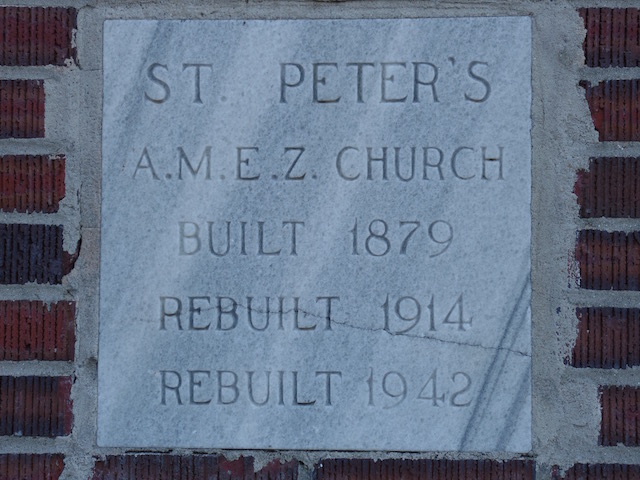
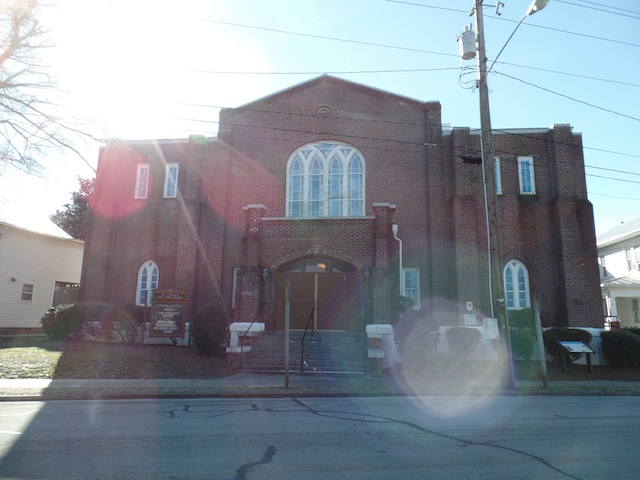
Cedar Grove Cemetery is one of the more famous cemeteries. The Churchyard of Christ Church was the towns principal buryial ground in the 18th century but in 1798 and 1799 there was a yellow fever epidemic. Too many people died during the epidemic and the churchyard was not going to be large enough, so they moved a bit further to the outskirts of town and established this cemetery. It was encircled by a magnificent paneled coquina wall in 1853 and has a towering triple-arch entrance. What makes the arch unique is that it's made from a locally quarried stone called 'shell stone' which is made up of sea shells and the fossilized remains of sea creatures. There is a legend related to this ... supposedly the arch "weeps" or "bleeds" on people as they walk under it. The legend goes that during a funeral procession into the cemetery, if one of the pallbearers is hit with a drop of liquid from the arch, they will be the next of the group to die and be carried in. Adding to the creep-factor is the old timers who can give examples of this occurring including names and dates. We saw the Major John Daves house earlier, and then we saw his final resting place.
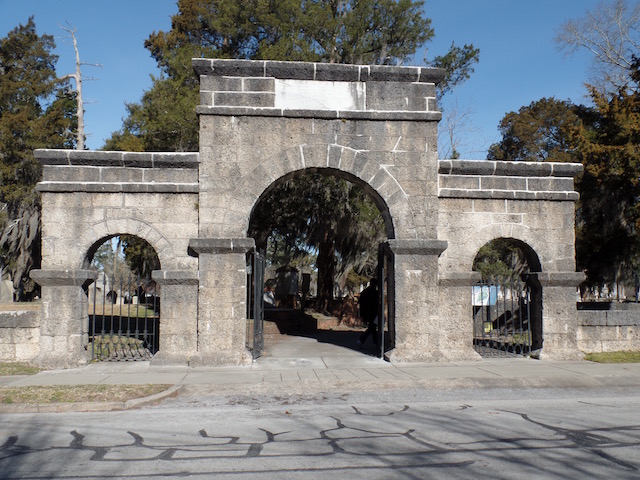
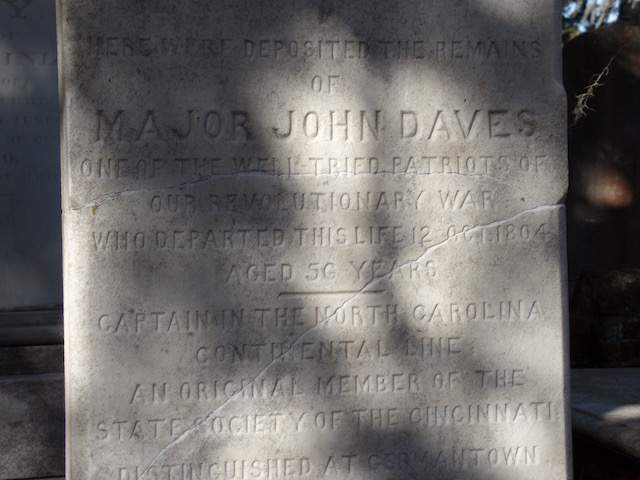
The Christ Episcopal Church was built in 1871, incorporating the brick shell of the previous church built in 1824. It is a brick church building in a restrained Gothic Revival style. It features a three-stage entrance tower, with a pyramidal roof and octagonal spire. We peeked inside to get a few pictures of the windows (hand painted and not stained glass) and the organ. They also have an outside "church" setup with benches where the first church was completed in 1751 (no longer there, obviously).
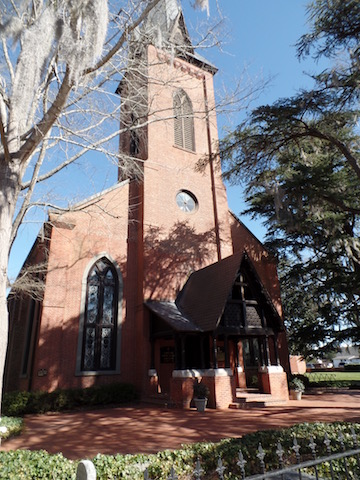
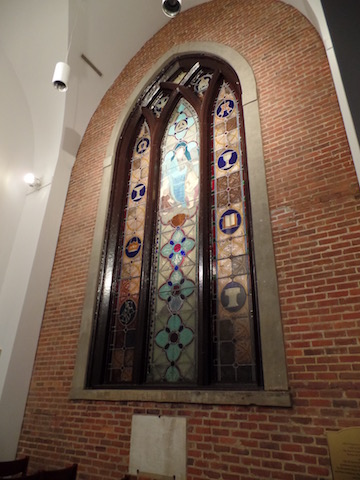
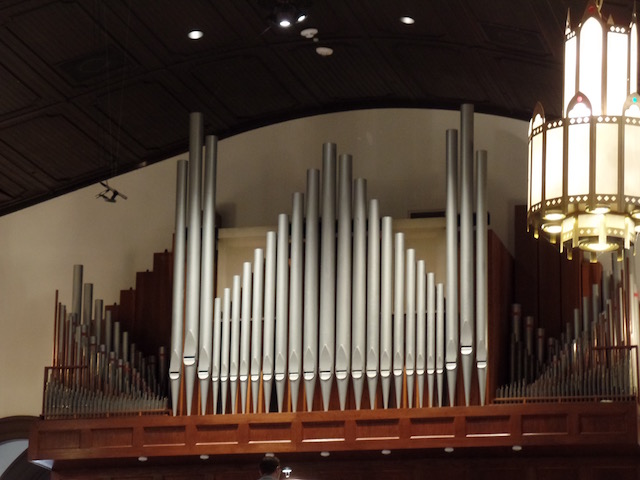
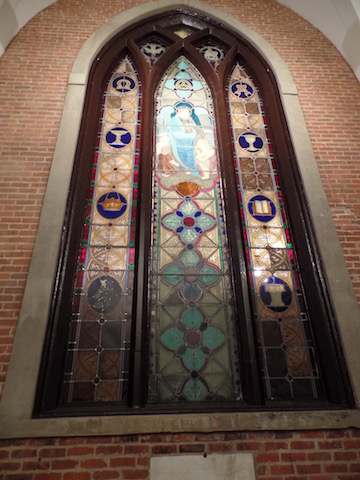
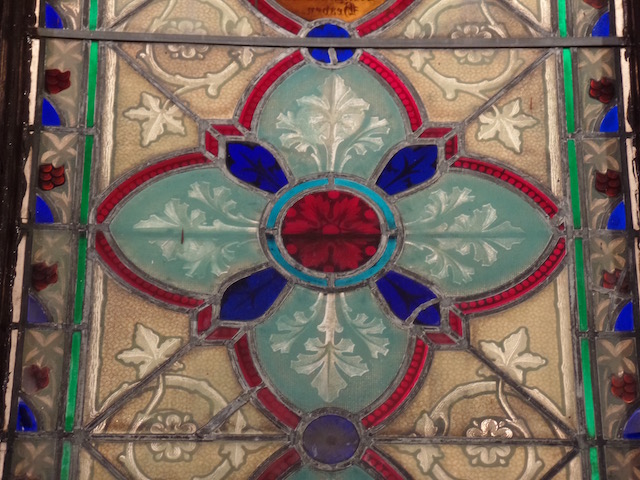
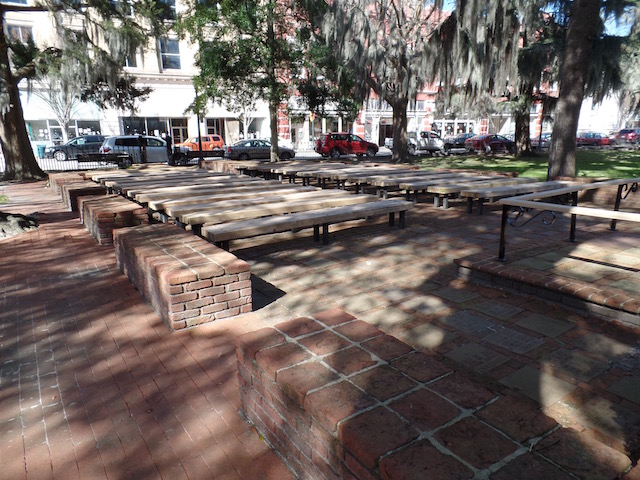
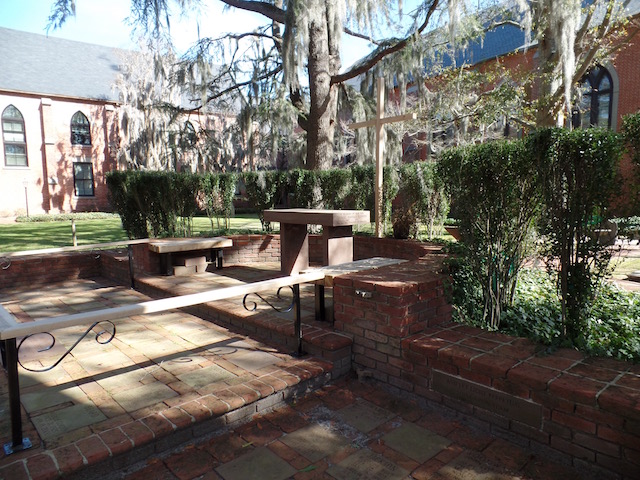
At the corner of the churchyard is a cannon, buried muzzle-down. This was supposedly taken from the British war ship the Lady Blessington, which was commandeered by one of the privateer ships of John Wright Stanly. On the return of Stanly's fleet to New Bern, this cannon was put on his wharf on Neuse river where it remained until in 1810 when Johnathan Price made by order of the town government a new survey of the town. There were two other surveys before Price one in 1728 and the other in 1779. The cannon was used as a starting point for Price in his survey.
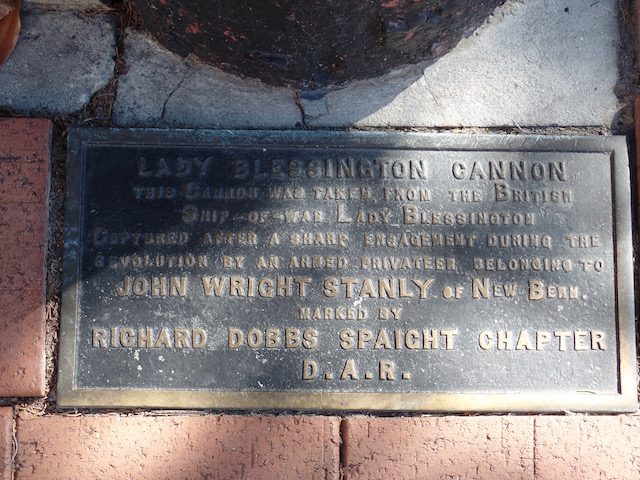
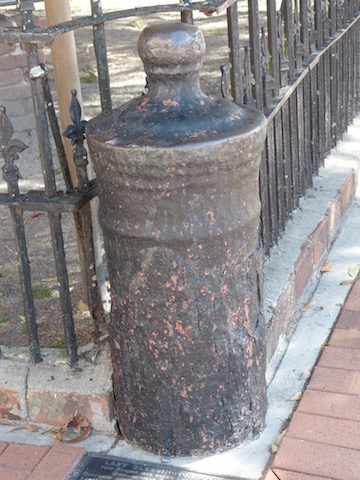
City Hall is an unmistakable landmark in downtown New Bern. At nighttime, drivers and boaters can't miss the brightly lit clockface, which serves as a beacon along the New Bern cityscape. James Knox Taylor designed the clock tower as it appears today, including the installation of a large Seth Thomas four-face clock. At night it is illuminated by red light bulbs mounted on each hand and white bulbs on each hour.
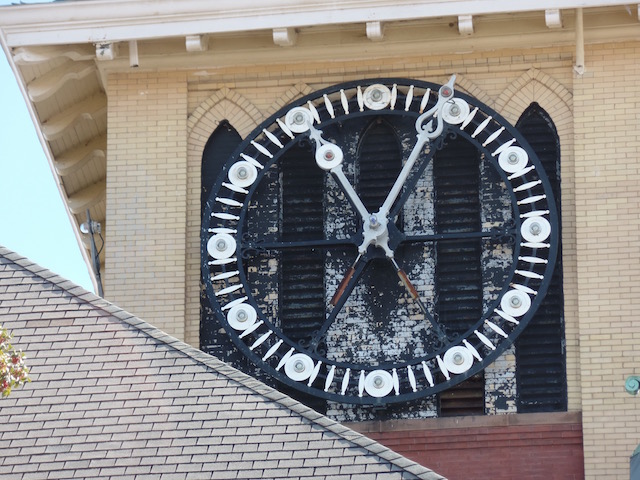
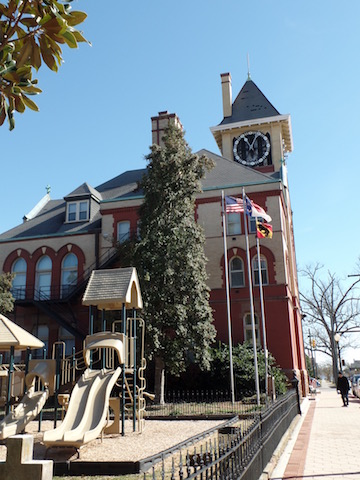
Near City Hall is a bust of Baron Christoper (or Christoph) de Graffenried, who was the founder of New Bern. led a group of Swiss and Palatine Germans to North Carolina in British North America in 1705. He later authored Relation of My American Project, an account of the establishment of New Bern. The bear with the tongue out is supposedly normal for the bears in Switzerland.
His story is a bit of an interesting one. With the idea of paying off his debts and making money on the cheap land of North Carolina, Graffenried left his debts to his father and secretly departed for London to make arrangements to move to the New World. n 1709, Graffenried next met with the Lords Proprietors of Carolina, who granted to him ten thousand acres on the Neuse and Cape Fear Rivers. They also gave him the title Baron of Bernberg, after the settlement he was supposed to found. He sailed with the colonists to North Carolina in 1710. On the sea, the settlers were attacked by French privateers who stripped them of everything they brought.
Once in the New World, the settlers sold everything that remained, except the clothes on their backs. John Lawson took them to a site at the junction of the Trent and Neuse Rivers, which they named New Bern. The first season, the settler's crops did not do well. Graffenried returned to Europe to get supplies and additional settlers. He returned to the colony unscathed.
During the summer of 1711, Graffenried, along with John Lawson, took a trip up the Neuse River. Graffenried wanted to crossbreed European grapes with wild, native grapes and start a vineyard. The Tuscarora took Graffenried, John Lawson, and an enslaved African captive. While in captivity, John Lawson and Graffenried were given three separate trials, each in a different Tuscaroran village. One found the men not guilty; the other two pronounced them guilty of wrongful crimes against the Tuscarora. The Tuscarora decided to kill them but, after extended discussion over several weeks, the elders decided Graffenried would be released. He wore such fine clothes they mistook him for the governor of North Carolina. They thought if they let the "governor" go, the colony would let the incident pass. They informed him they were planning an attack on all the settlements in North Carolina (when this took place, it was known as the Tuscarora Indian War). The next day, the natives killed Lawson after ritual torture. Graffenried was released on condition that no new European settlements should be made without the sanction of the native chiefs. When he finally reached New Bern, he found it abandoned and in flames.
Having lost his fortune, Graffenried returned penniless in 1714 to Bern, Switzerland. He owed a great deal of money to the Proprietors of North Carolina, who had funded his settlement expedition. He sold his part in New Bern to Thomas Pollock for 800 pounds. In an attempt to pay off his debts, Graffenried soon wrote a book entitled Relation; it was his apology and explanation as to why his settlement failed. He included several documents, among them a letter written to the governor of North Carolina and a layout of the settlement of New Bern. An artist, he included sketches of early colonial North Carolina. Graffenried also wrote that Lawson brought his death upon himself. He said that Lawson was a money grubbing land speculator, and that he thought Lawson wanted the colony to fail because he was the one who had told them how good the land was. Graffenried died unhappy and in debt in 1743.
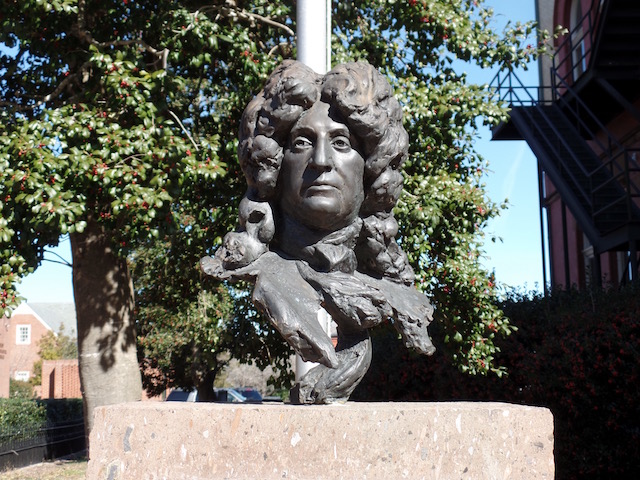
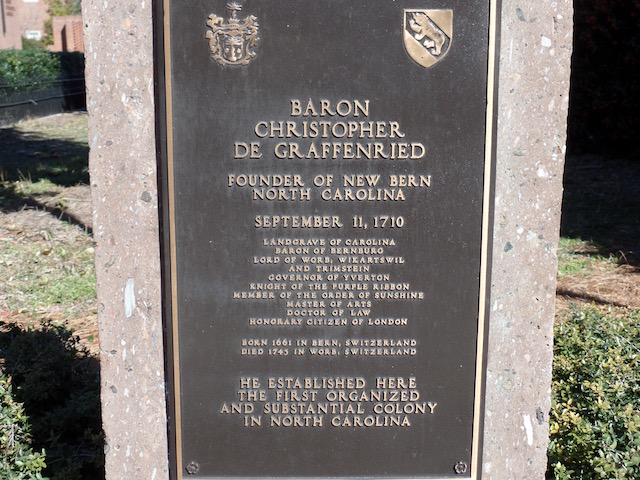
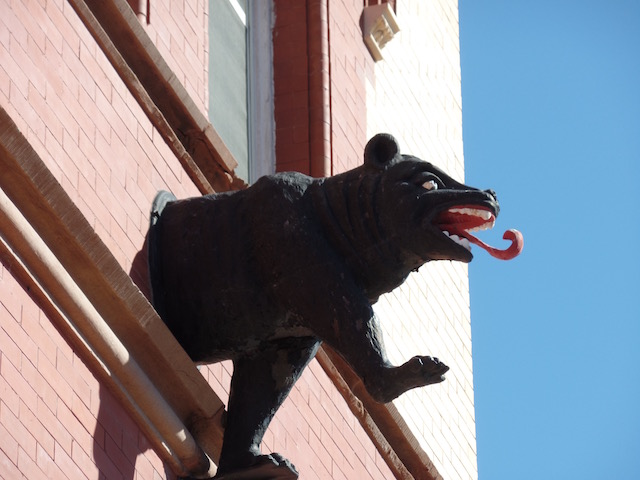
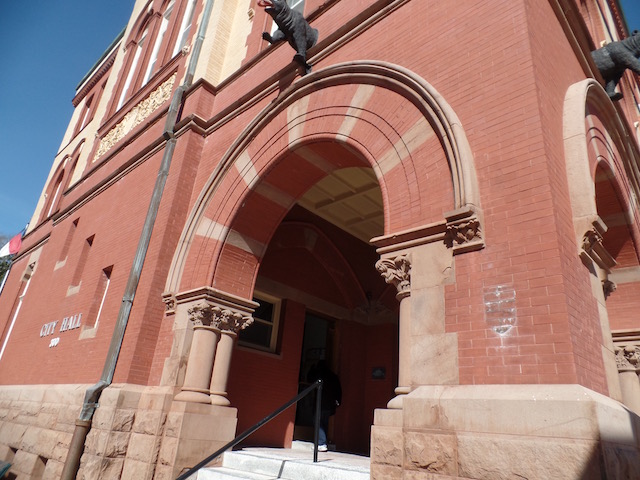
The corner building is the former S.H Kress and Co. Store. We found a newspaper clip that indicated that the Kress and Co. store opened on 9 Nov, 1909 although I wasn't able to figure out if it was at this location. It was the site of a sit-in in the 60's. On March 17, 1960, a week after the nationally reported sit-in protesting segregation took place in a Greensboro Woolworth, 29 black youths from J.T. Barber High School staged their own sit-in at Clark's Drug Store.
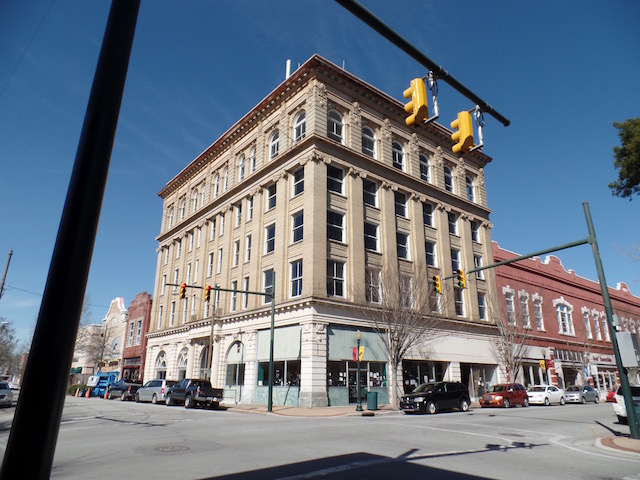
The First Baptist Church, founded in 1809, is one of the few churches right in the middle of downtown. This one is a signature Gothic Revival structure with high turrets and diamond panel glass windows. The building itself dates back to 1847.
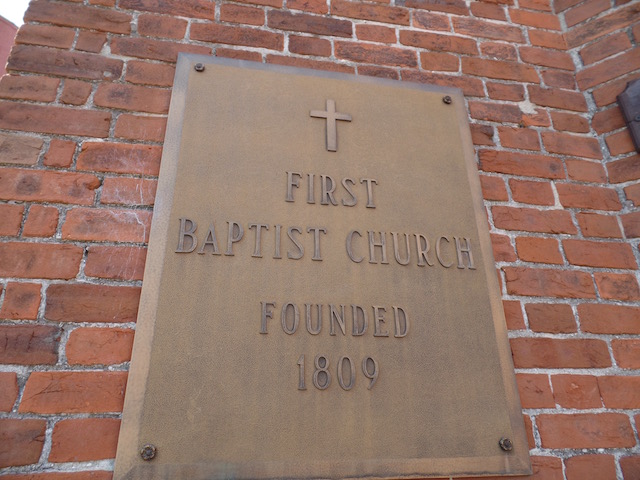
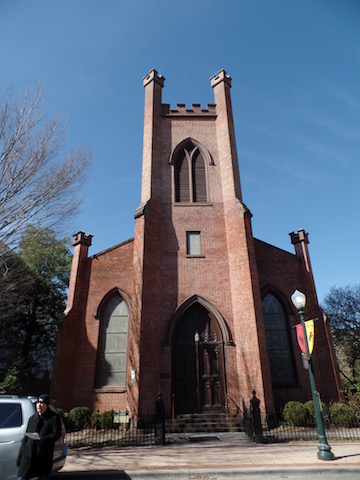
This building is a little unique. At the top you see a sign for Coplon Investment Company, which was build in 1927. Below that, on the first floor, is the lovely red sign of O. Marks, which was Oscar Marks & Son. They had a store for dry goods and shoe sales operations. Following Oscar Marks death in 1921, business declined and the firm closed its doors in 1927.
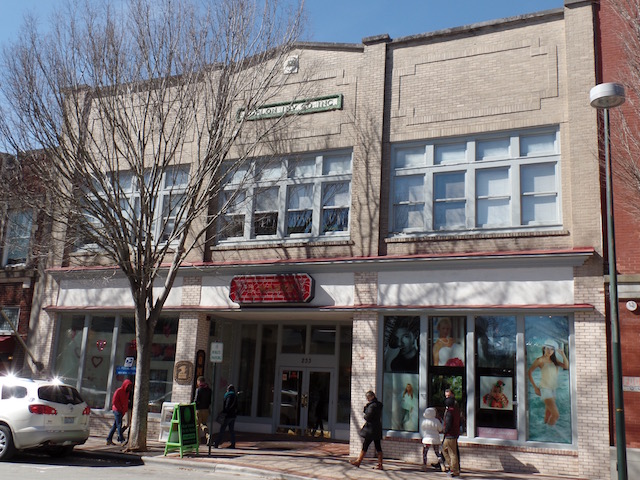
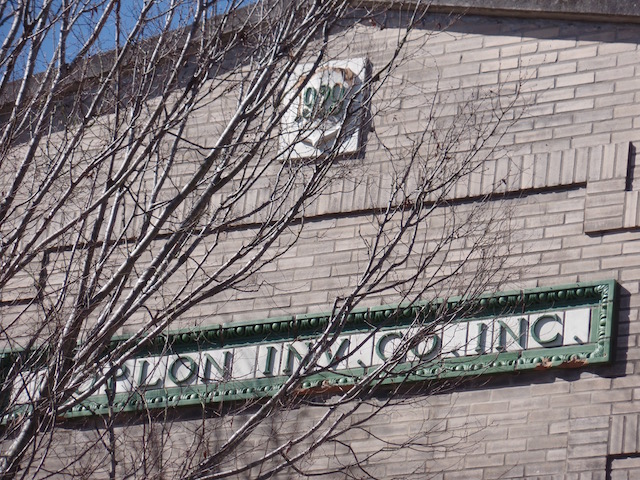
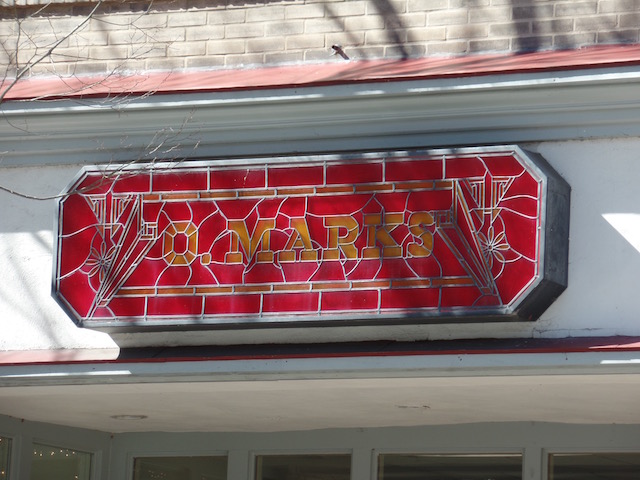
The Harvey Mansion was built about 1810 and is a three-story, brick dwelling (painted white) with an exposed basement. It was the family home of the Harvey family. The 3rd floor was converted to a B&B in the 1990's and it seems to have 3 rooms. John Harvey, a ship owner and merchant originally from England, moved to New Bern with his wife Mary in 1797. Construction of the 9,000 square foot home began that same year and continued until 1804. During the Civil War when New Bern was under Union occupation, the house was used as a military provost headquarters. The home remained in the Harvey family until after the Civil War. In the ensuing years it has seen various uses, including a boarding house, a dormitory for the New Bern Military Academy, apartments during WWII (for Cherry Point) and the original location of Craven Technical Institute (Craven Community College).
In 1974, the Harvey house was vacant and in poor repair. The city attempted to have it torn down, however the Keeper of the National Register denied the request and it was added to the National Historic Registry. There are rumors of ghosts that inhabit the mansion. One is a lady who walks though rooms and out walls, and another is a five year old girl.
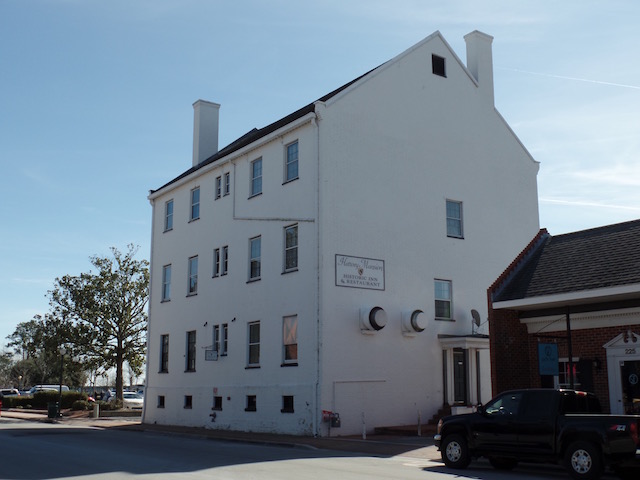
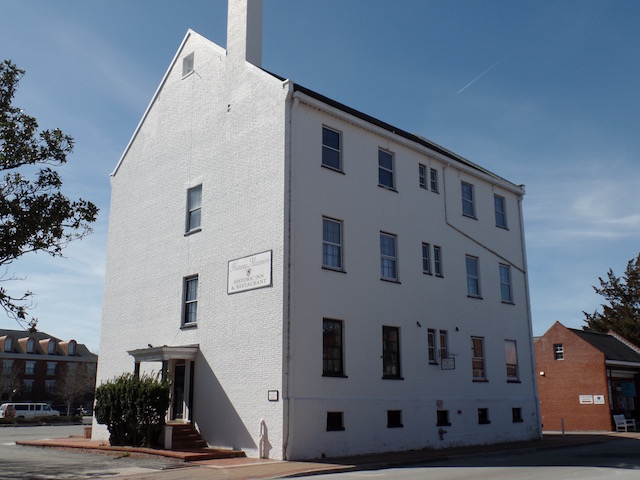
I thought this was a really interesting house architecturally, although it wasn't on any historic homes map.
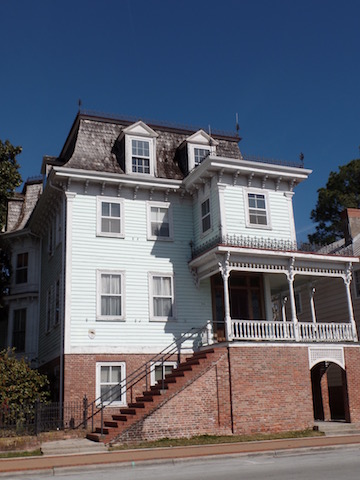
This is really not a historic home at all, since it only goes back to 2007, but the Francoeur house had this really cool picture on thew all of the porch near the front door.
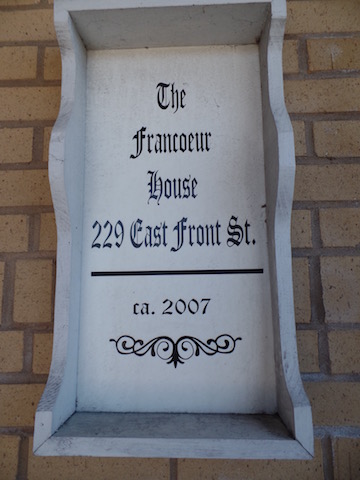
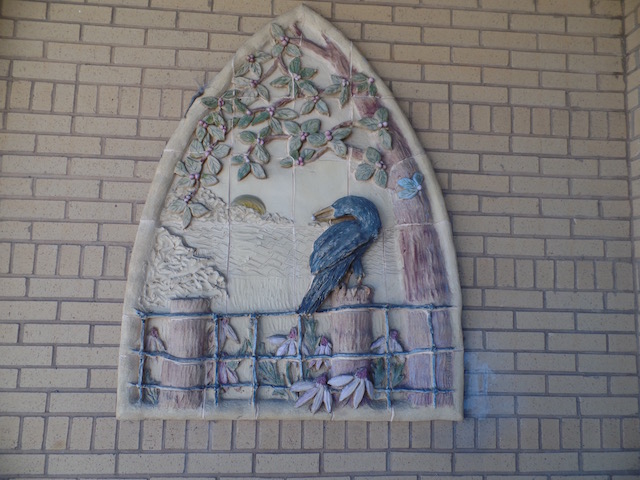
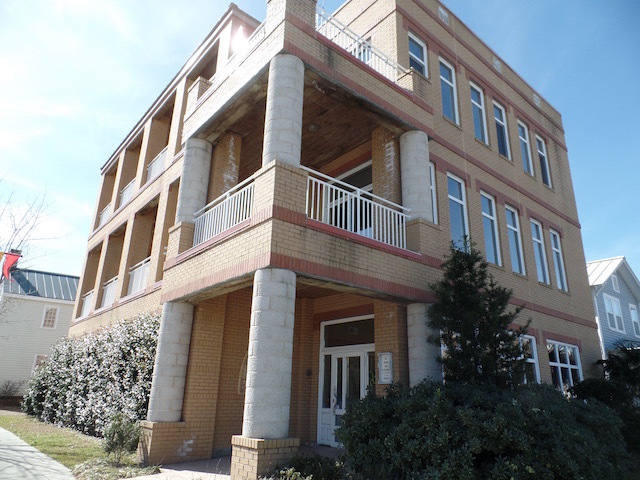
Another house that I don't find on the walking tour, but it looked really interesting.
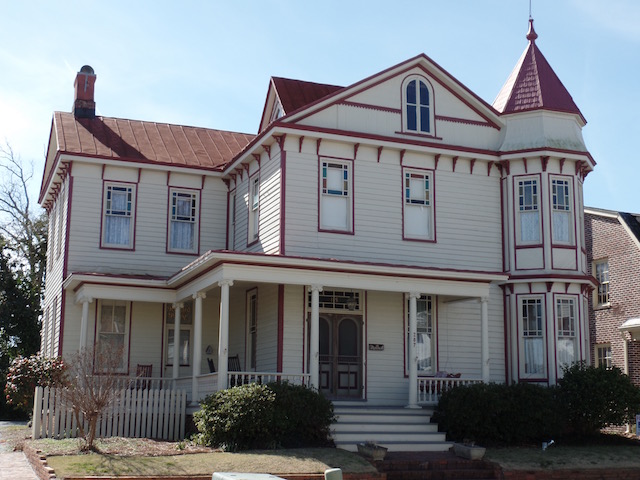
This is the Craven County Courthouse. The courthouse is among North Carolina's finest examples of the Second Empire style. A previous courthouse burned in 1861, but the Reconstruction era economy postponed the construction of a new courthouse until the 1880s.
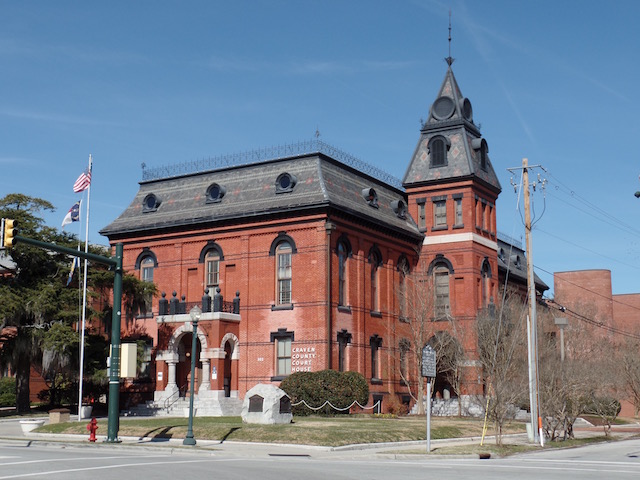
This is the Baxter Clock, which is approximately 20 feet tall and illuminated at night. It was manufactured in 1920 by the Seth Thomas Clock Company and erected in 1930 opposite the front entrance of Baxter's Jewelry Store. The four-sided clock has brass and steel works contained in a spherical cast iron case which consists of three stages. It was listed on the National Register of Historic Places (NRHP) in 1973, but in 1977, an accident resulted in the broken clock being placed in storage for almost fourteen years. The Baxter Clock is thought to be one of three operating clocks of its kind remaining in the country.
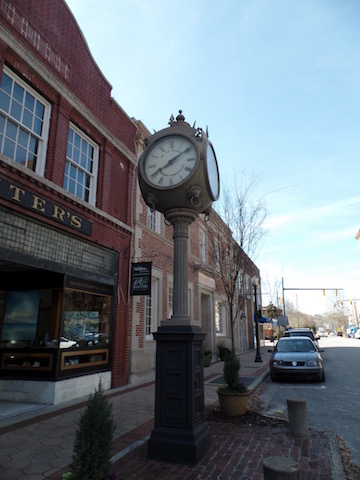
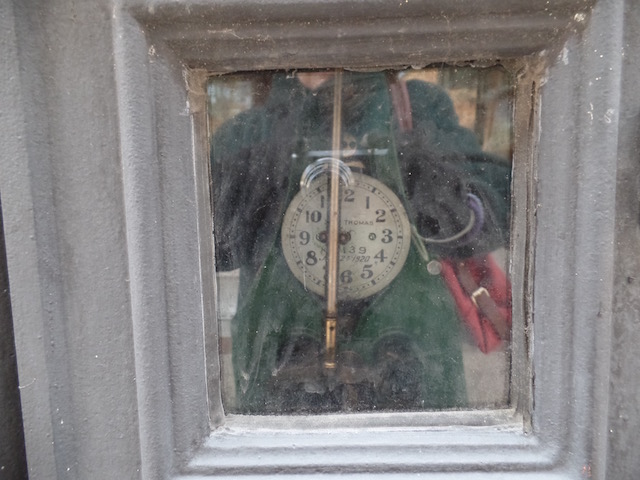
Then we headed over to the Tryon Palace, which is one of the main highlights of the city. William Tryon was a British soldier and colonial administrator who served as governor of the Province of North Carolina from 1765 to 1771. Tryon had seen the need for a centrally-located Government House even before assuming office. After assuming office, he worked with architect John Hawks to draw up plans for a government house similar to other British colonial structures of the time. In 1770, Tryon moved into the Palace (at the time, "palace" was a standard word for any public building of this type). The house was a monument of opulence and elegance extraordinary in the American colonies.
The construction of the house was surrounded by controversy since it required extra taxation on the citizens of the province, who had already felt overburdened with taxation. It proved to be too much and served as a major catalyst in North Carolina's War of the Regulation; which culminated in the Battle of Alamance on May 16, 1771, and later led to the hanging of seven men. The unpopular Tryon left North Carolina on June 30, 1771, to become governor of the Province of New York on July 8th of that year. He had only lived in the house a little more than a year.
In May 1775, when the American Revolutionary War began, Governor Josiah Martin fled the mansion. Patriots seized the Palace and converted it into the state capitol building. After Raleigh was founded as the state capital in 1792, the Palace was used for many different purposes, including a school, a boarding house, and a Masonic lodge. A cellar fire started in 1798, consuming the Palace proper. Only the Kitchen and Stable Offices were saved. However, the Kitchen Office was destroyed in the beginning of the 19th century to build a major road. Of the original buildings, only the Stable Office still stands.
In the 1930s, a movement began to preserve Colonial New Bern. The movement was bolstered by the discovery of the original Palace plans. The first obstacles to overcome were moving as many as 50 or more buildings, rerouting U.S. Highway 70, and building a new bridge over the Trent River. It was opened again in April 1959.
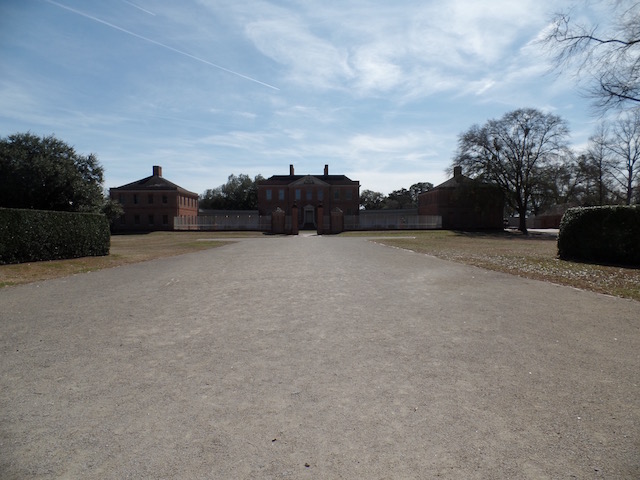
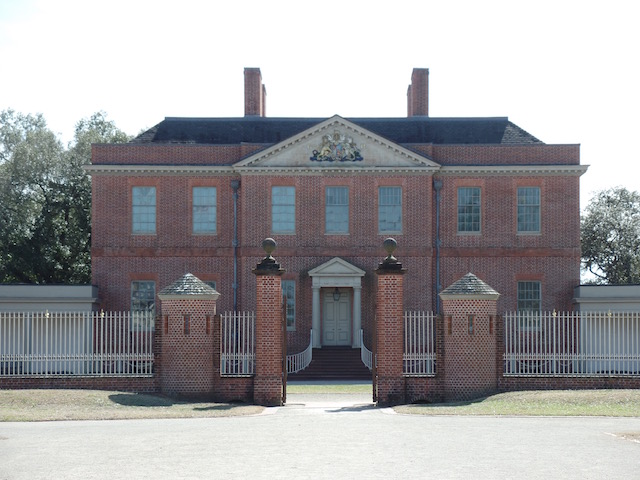
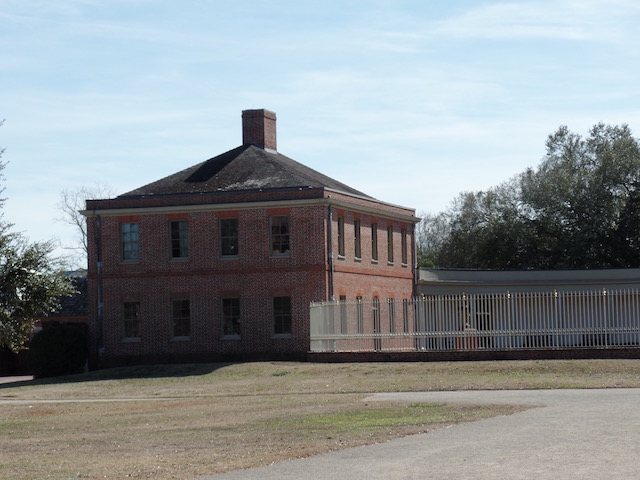
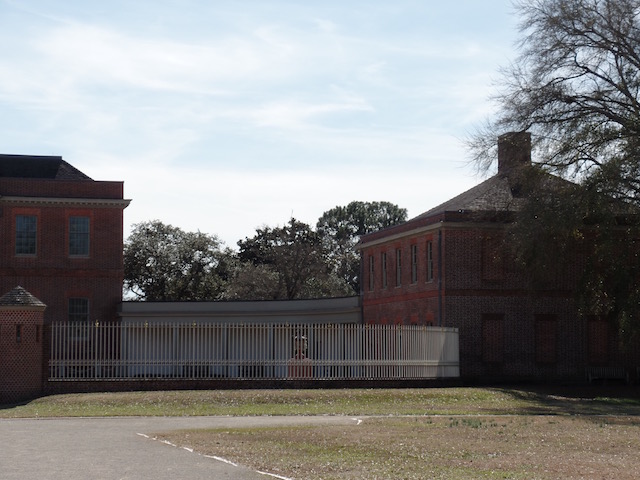
This is the blacksmith shop, which was closed when we were there but they sometimes hold demonstrations there.
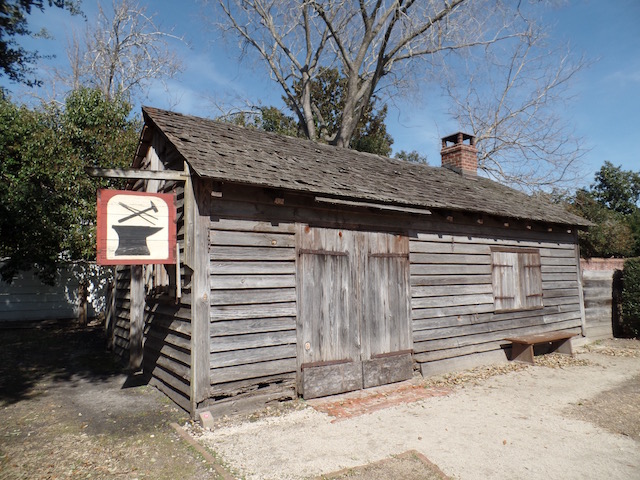
Little guardhouses flank the front gate.
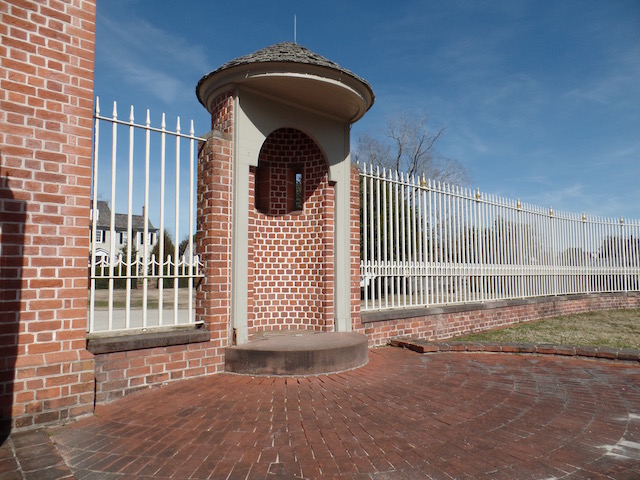
The reconstructed Kitchen Office, which is detached from the house. The original 1767 architectural plans show that the first floor of the Kitchen Office included the kitchen itself, a scullery for the cleaning and storage of dishes, a wash house, and workspace for the governor's secretary. The second-floor rooms were intended for servants chambers, and a Llundry. It represented the very latest in modern conveniences of 1770. They do cooking demonstrations here normally, using only things that were found in the time period. However, he wasn't cooking the day we were there.
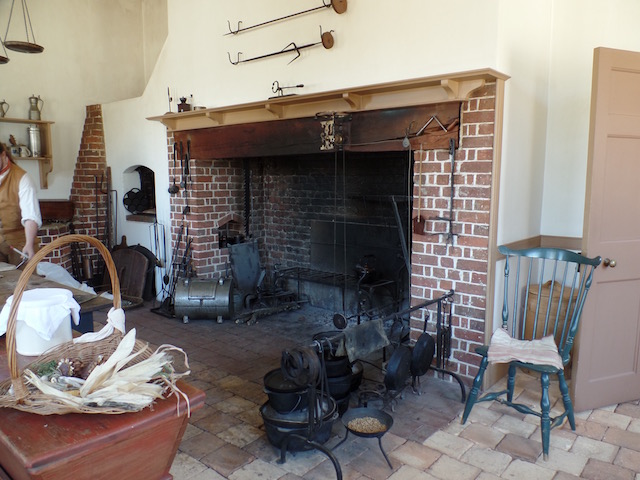
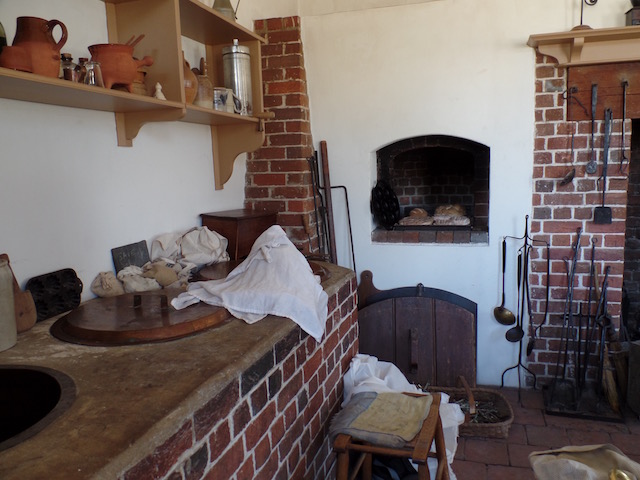
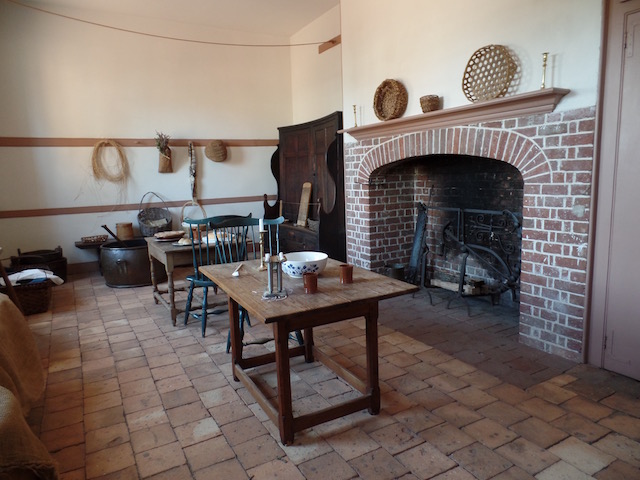
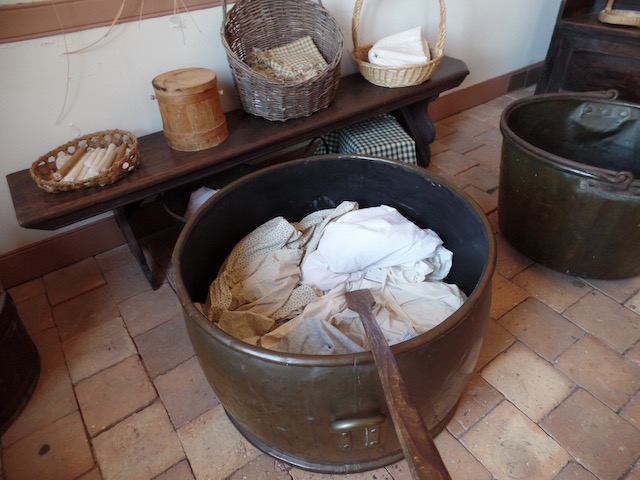
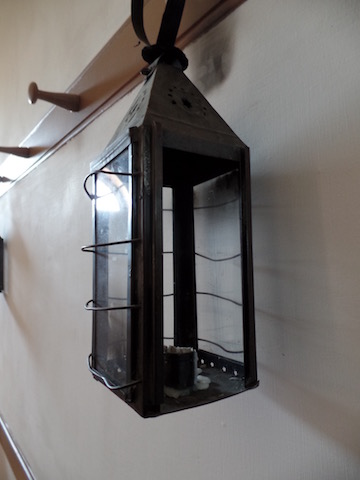
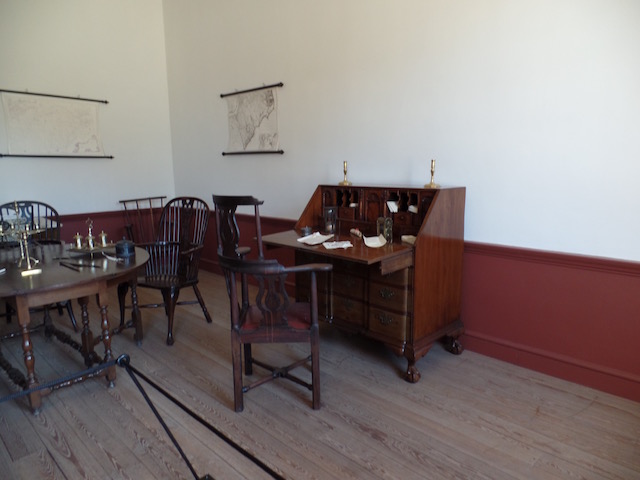
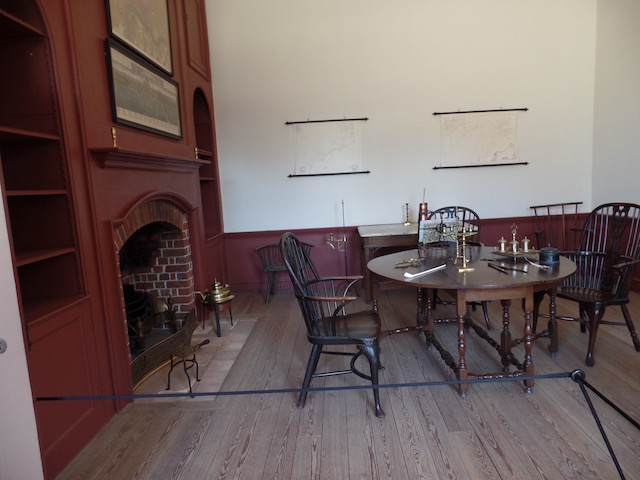
The servants quarters were actually pretty large and open for being servants quarters!
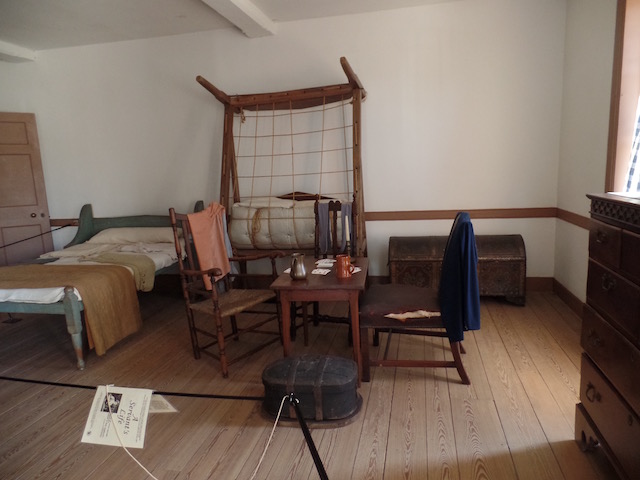
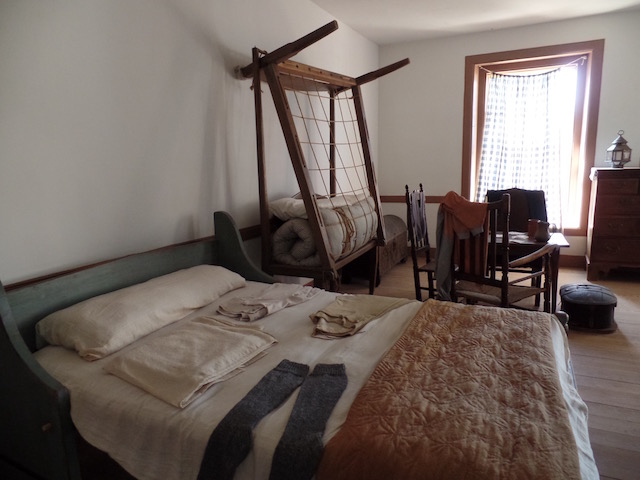
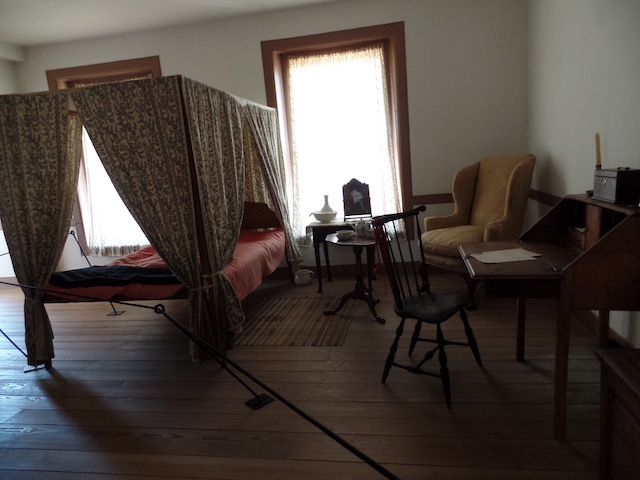
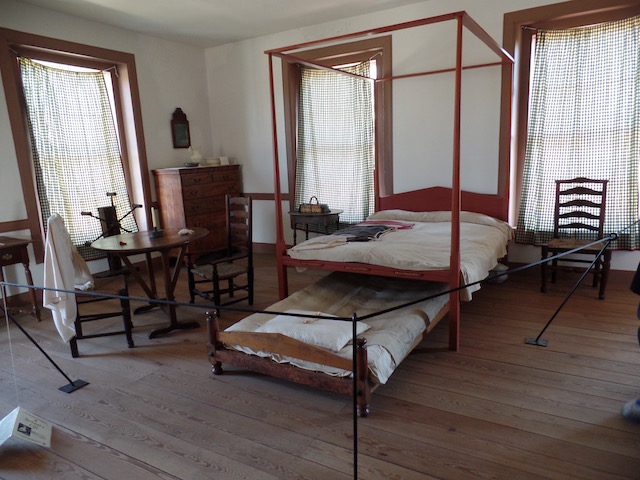
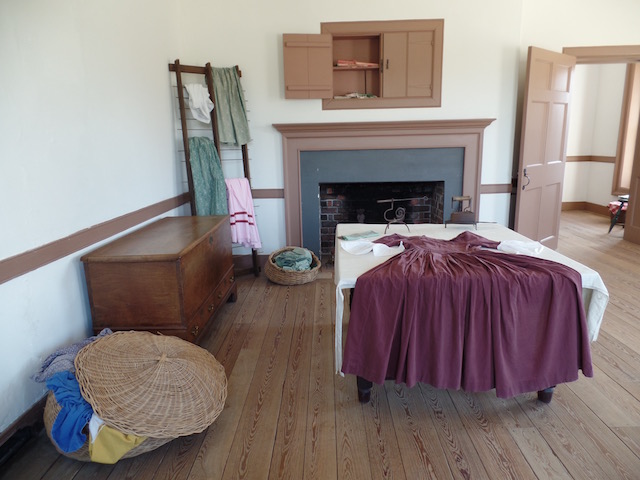
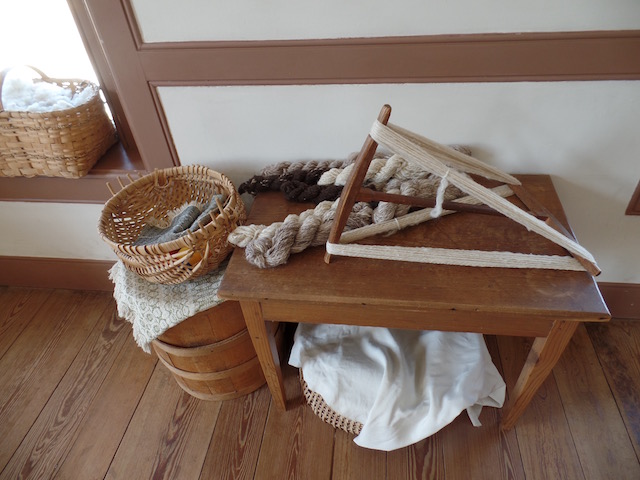
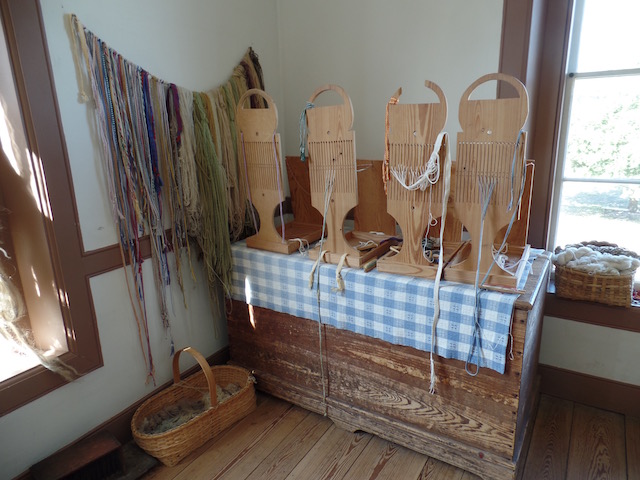
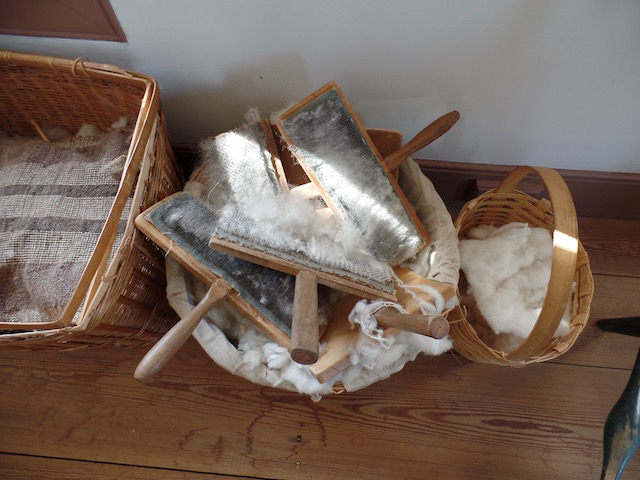
The stable is the only original building that remains. The Stable Office, as it is called, featured two rooms for stables, one with four stalls and the other with six, as well as a Coach House and Harness Room. In a later description written in 1783, Mr. Hawks added that the Stable Office also included bedrooms for the servant employed in the stables and lofts for hay or fodder etc.
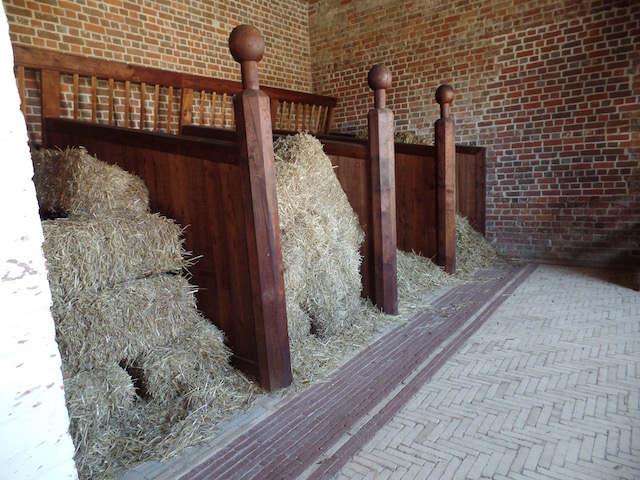
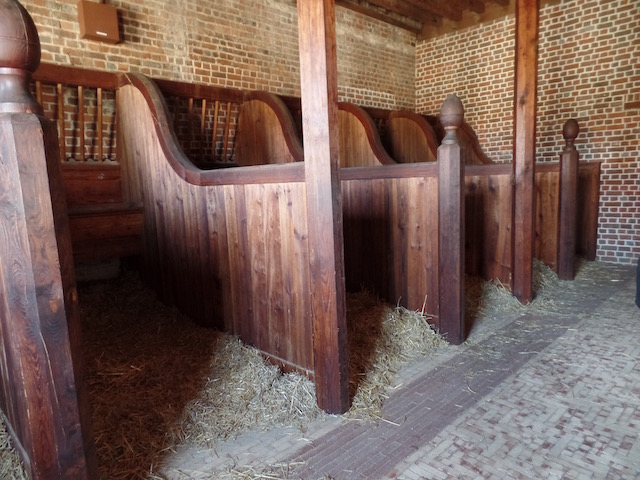
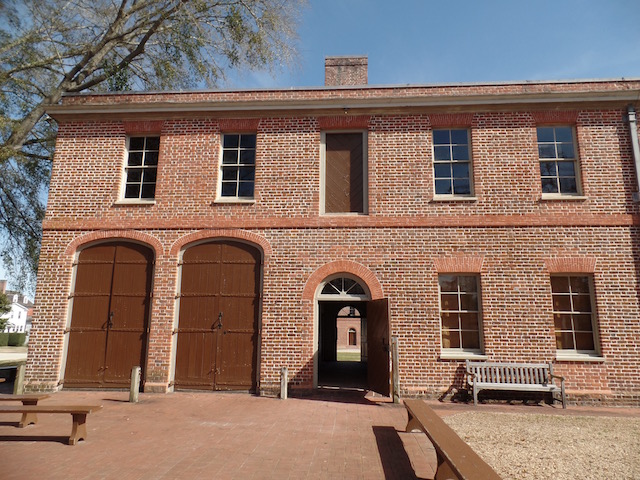
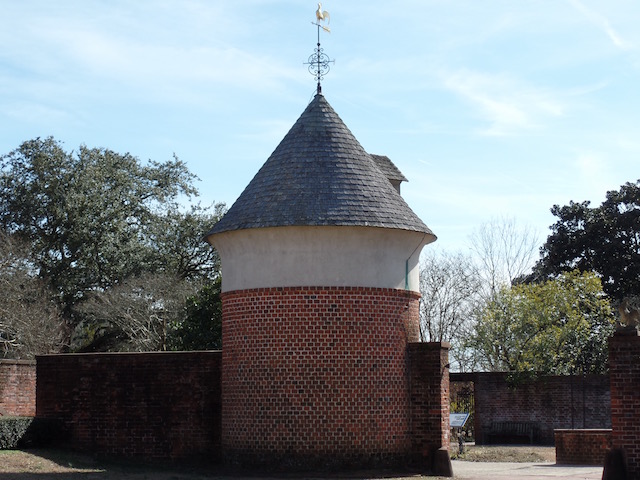
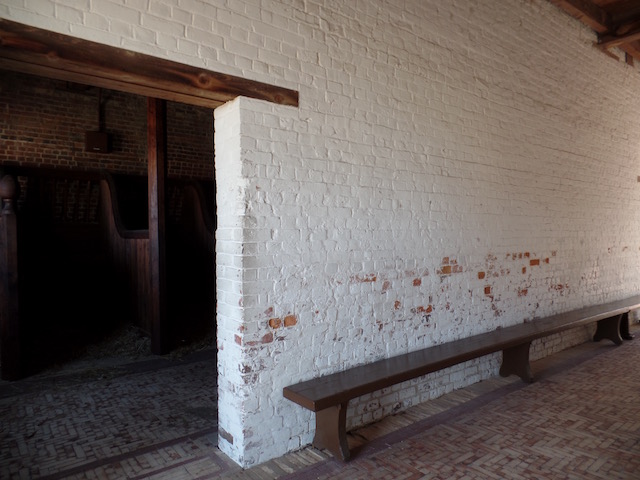
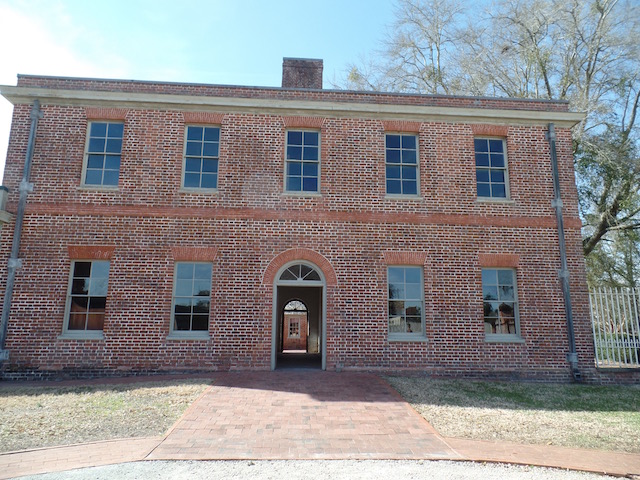
Back to the front of the main house building, up in the eaves is a coat of arms of the House of Hanover. You can see the G III and R, which is for King George III and his wife Charlotte of Mecklenburg-Strelitz (sometimes known as Carlotta Regina).
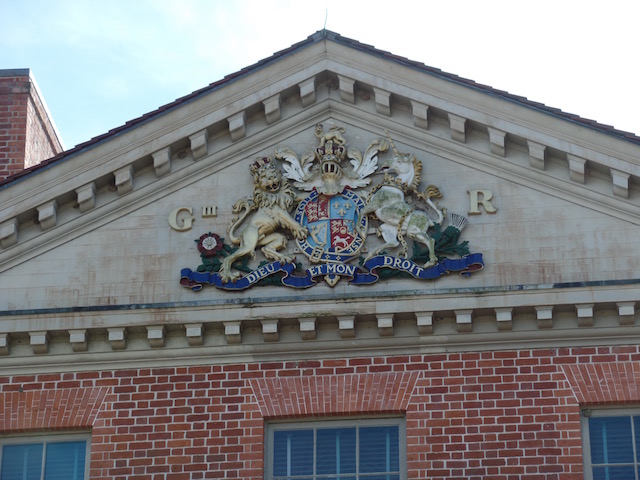
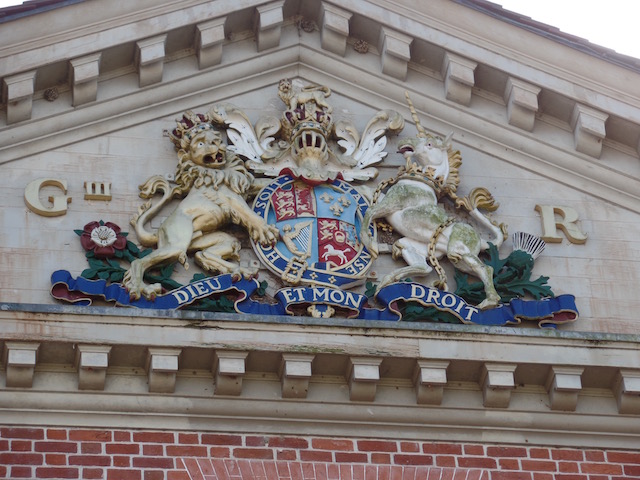
Inside, the foyer has a lovely marble floor and high ceilings, with another coat of arms.
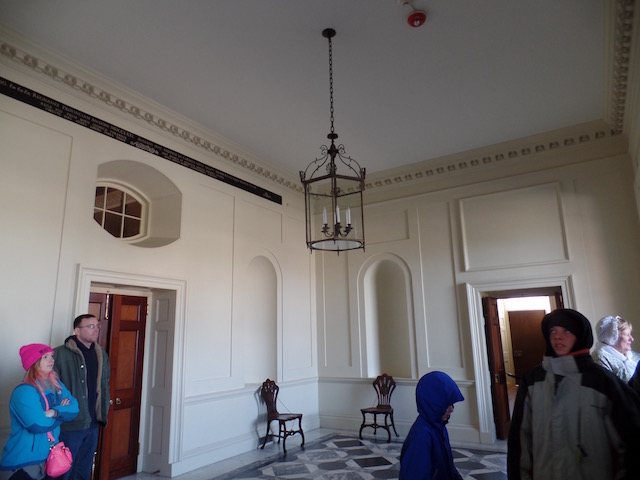
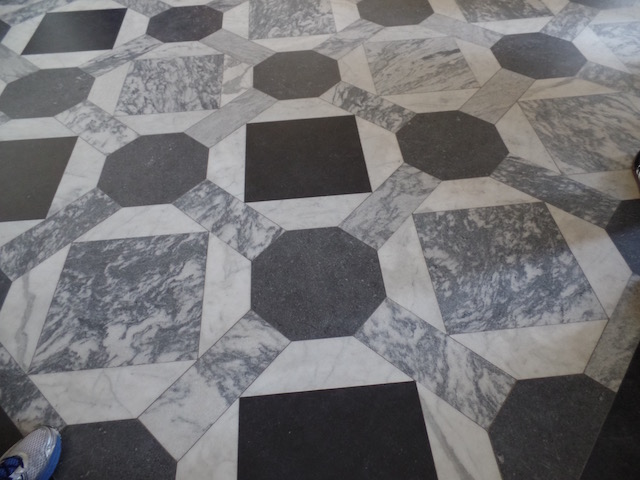
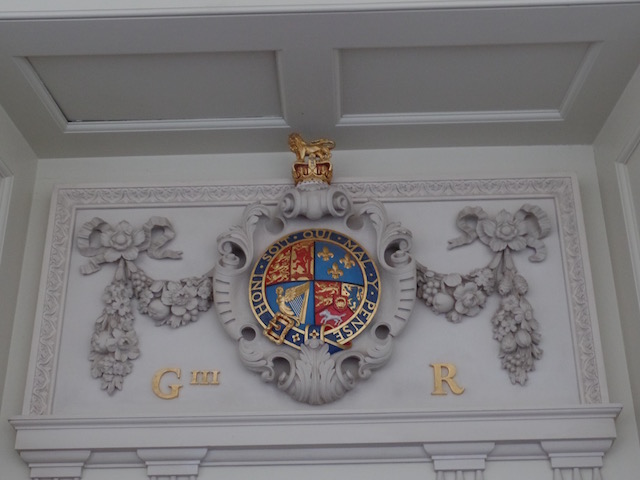
I took LOTS of pictures throughout the palace and I won't talk about all of them (or this blog would be way too long). The first room was basically for the doorman or the butler. He had a desk in front of a front window to allow him to see as people would come up to the front door.
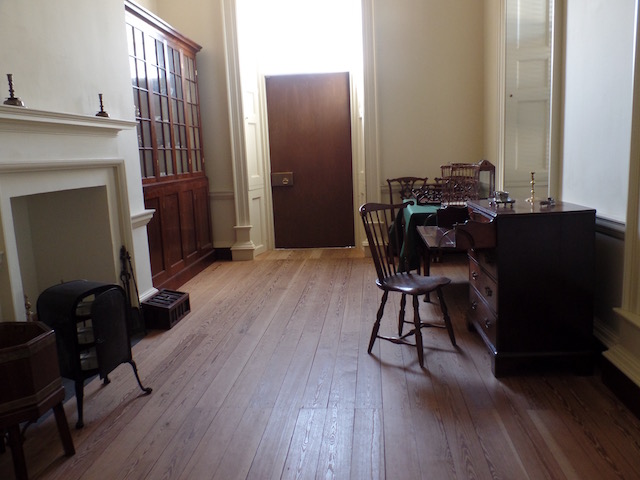
Then there was a library with lots of very old books. Note that almost none of the furnishings in the palace are original, since it was burned down and rebuilt. But everything would be period furniture and they attempted to furnish it with roughly the same pieces that were listed on an inventory when the governor moved into the palace.
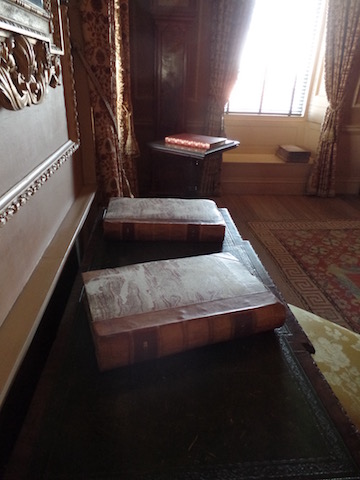
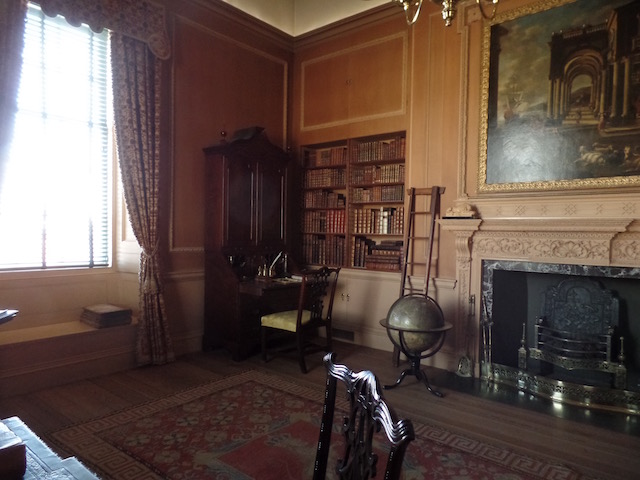
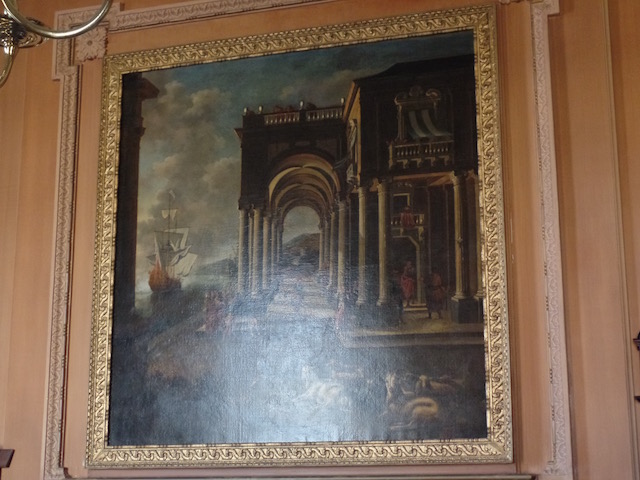
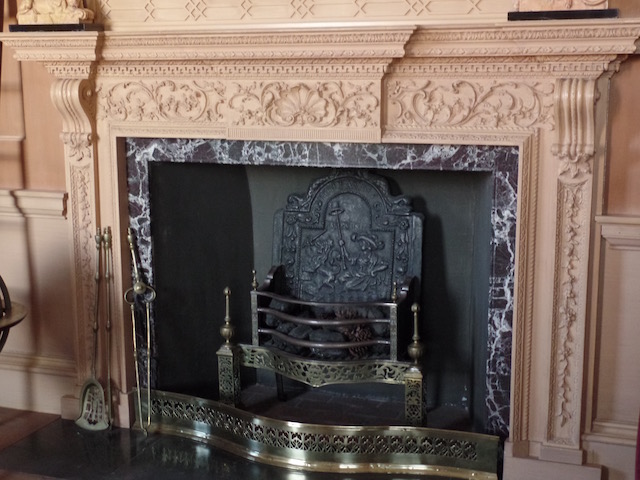
This room has a painting of King George III. Again is the coat of arms and, flanking the fireplace, were the names of King George III and his wife, Carlotta Regina.
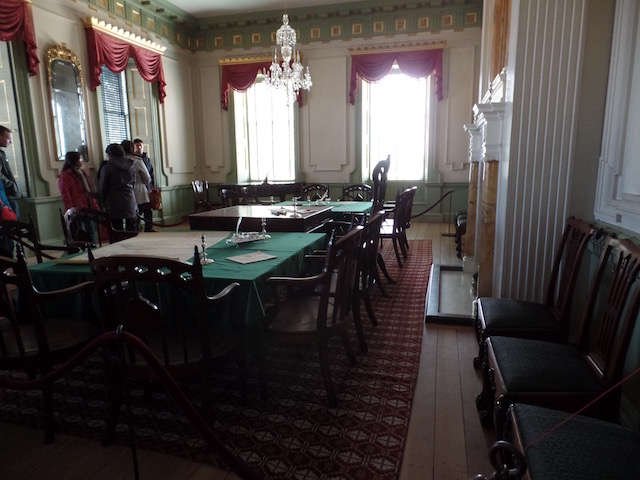
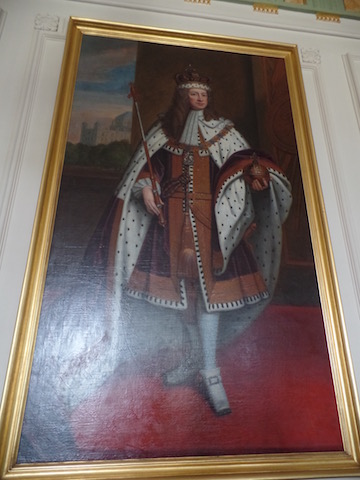
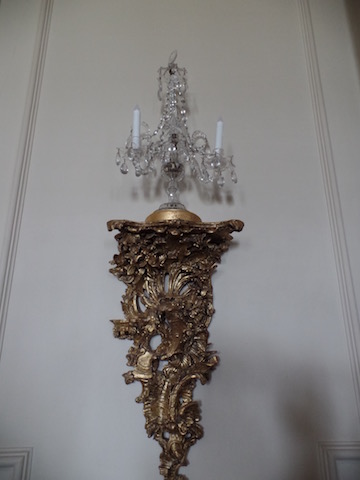
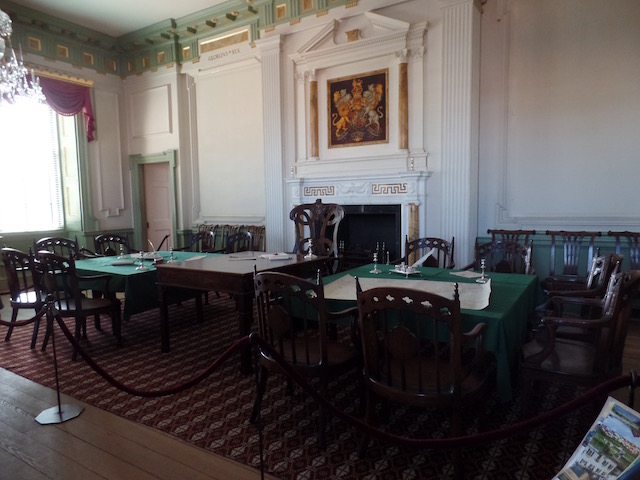
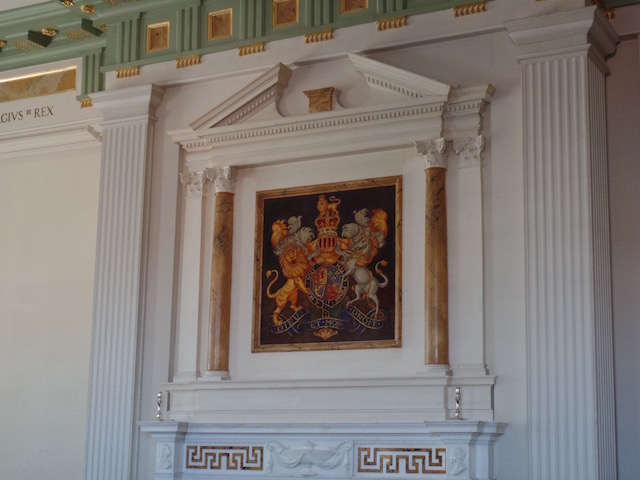
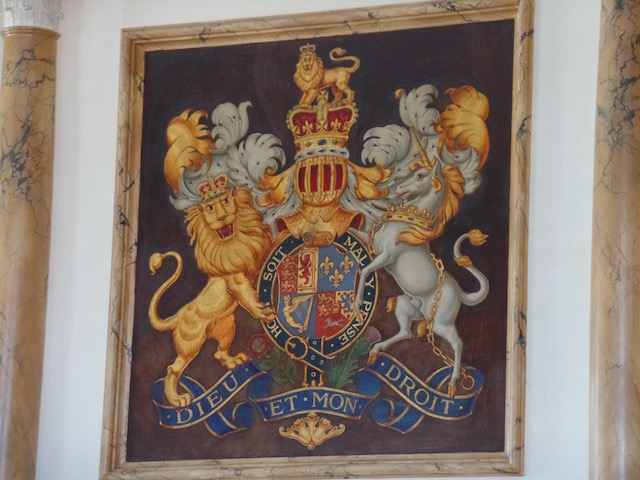
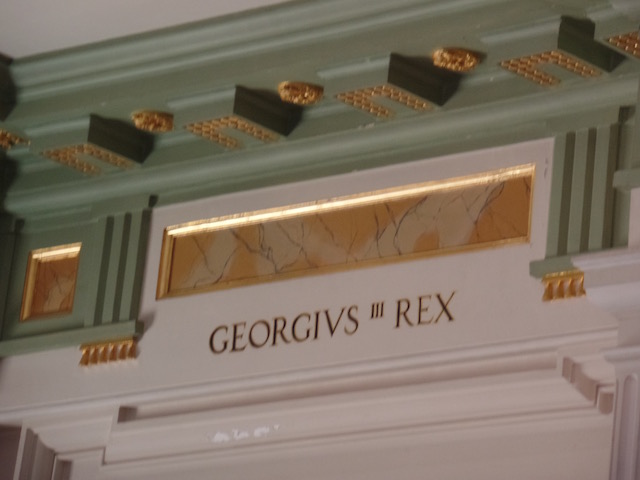
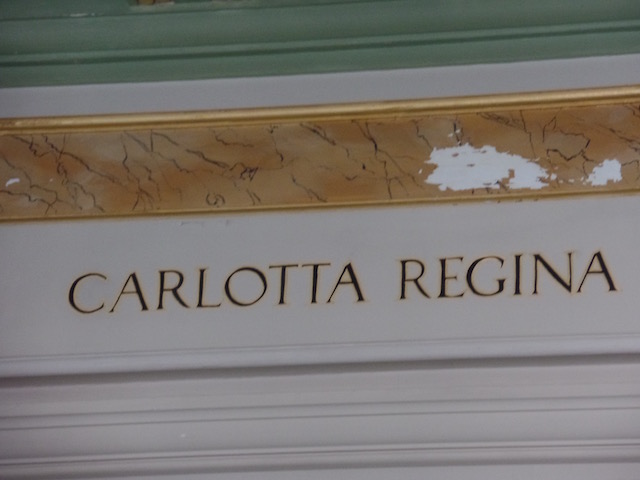
This room was used mostly by the ladies, having tea or playing music.
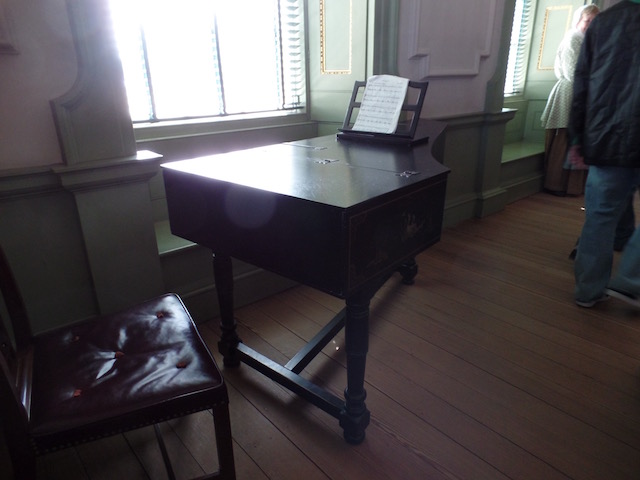
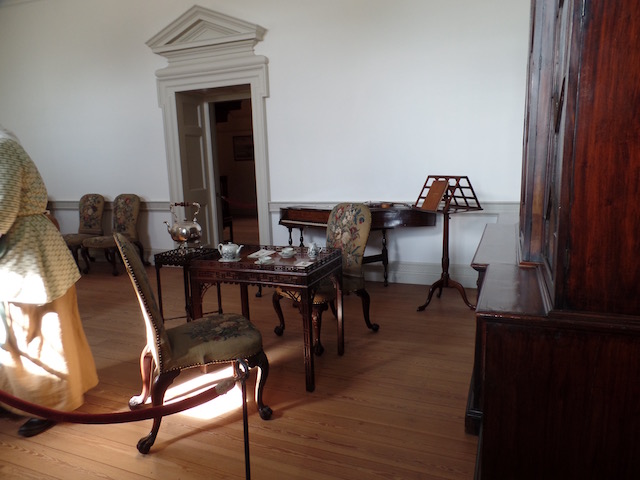
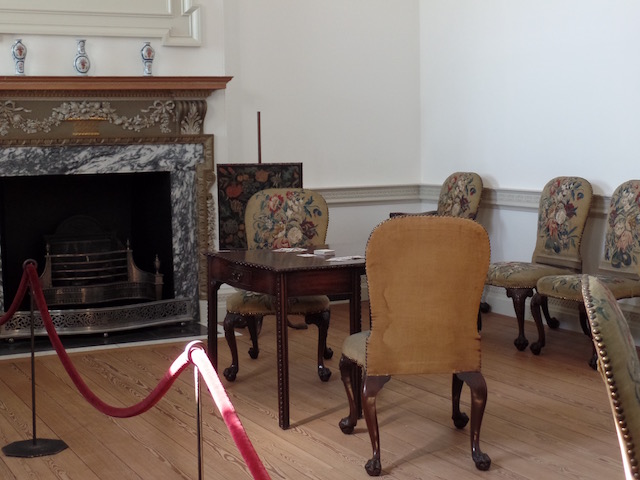
Here is the dining room with the table setup with food. The guide mentioned how breakfast and dinner were taken in the bedrooms and the main meal was what we would deem lunch, served around 2pm. Supposedly it was multiple courses with time between, and dinner tended to be leftovers (go figure).
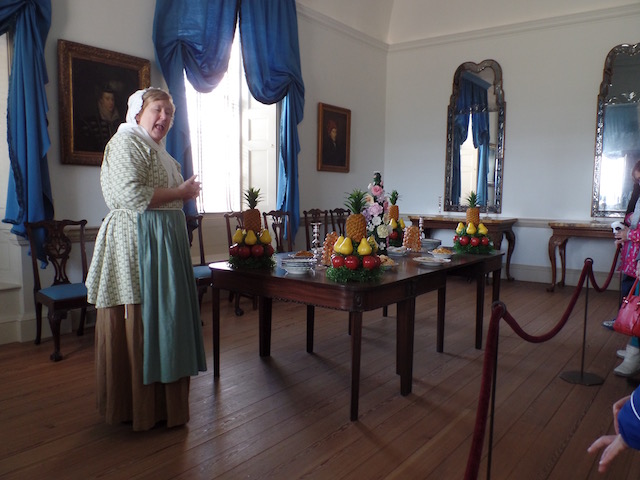
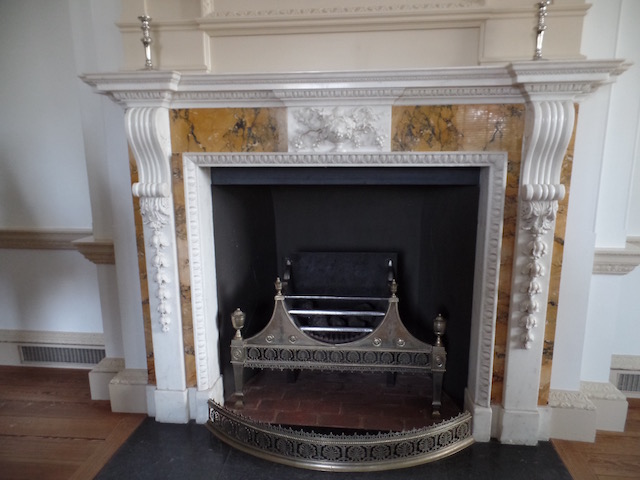
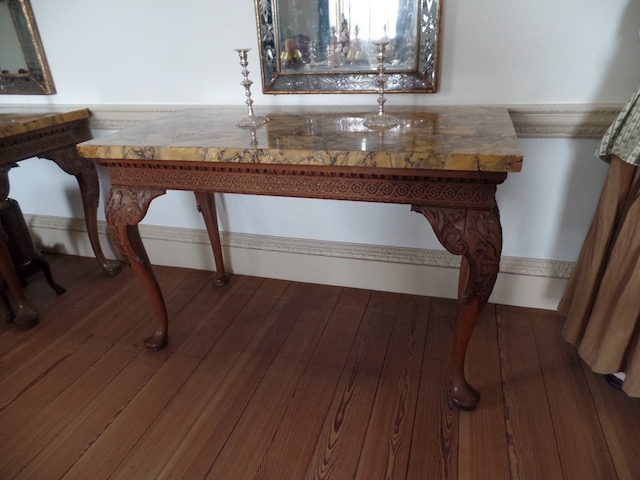
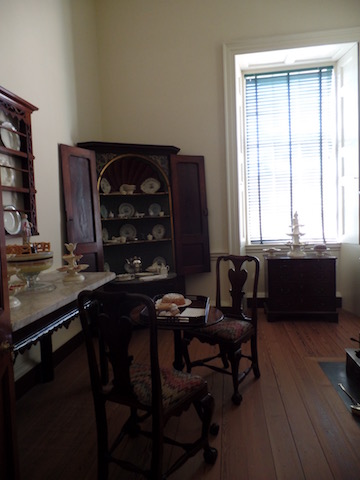
The grand staircase, which was rebuilt using no nails, like the original would have been.
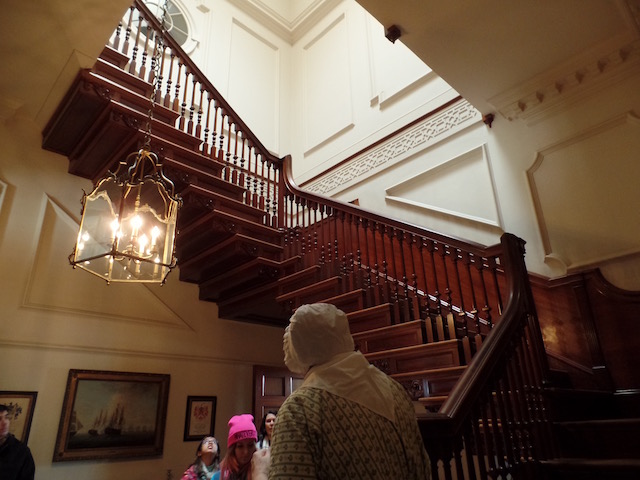
The various bedrooms upstairs were all furnished with period furniture. She noted that there are no bathrooms, which there wouldn't have been at that time. Each room had a wash basin that would be used to clean in the morning, and a chamber pot (which got emptied throughout the day). One of the rooms had clothing pieces from the period laid out and I'm really glad I wasn't born back then. The corset as well as various "pads" as the fashion of the day was to have skirts that were pushed out. She also mentioned that the shoes were the same on both feet (not a left and right shoe) and that eventually, they somewhat molded to your feet.
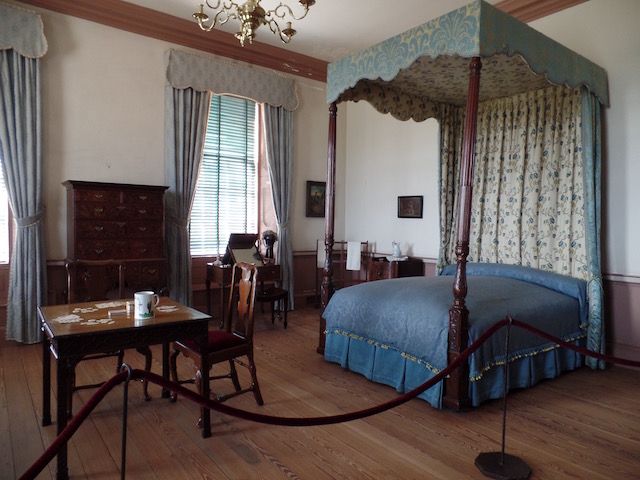
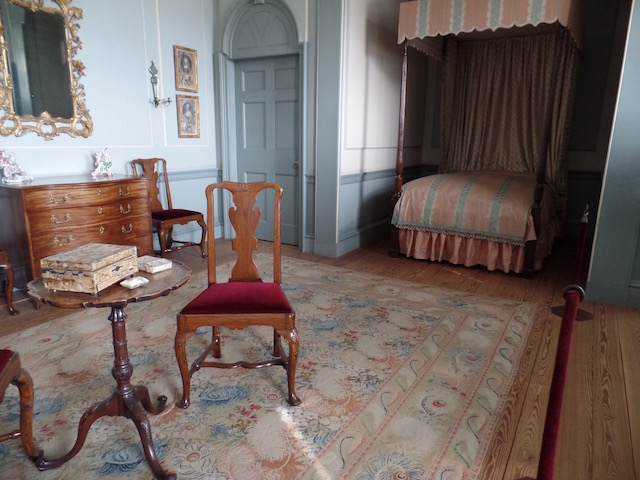
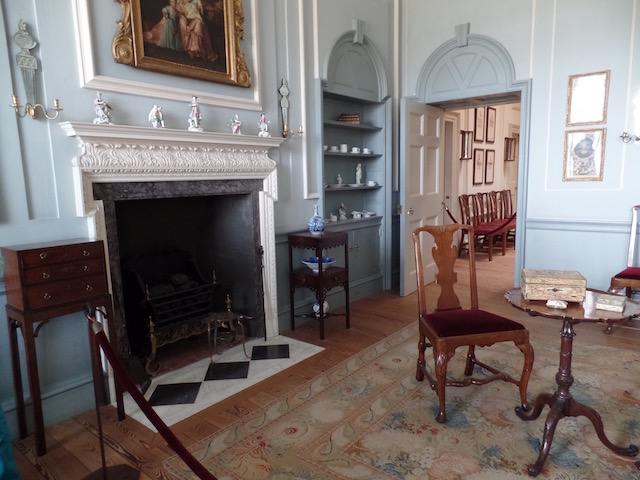
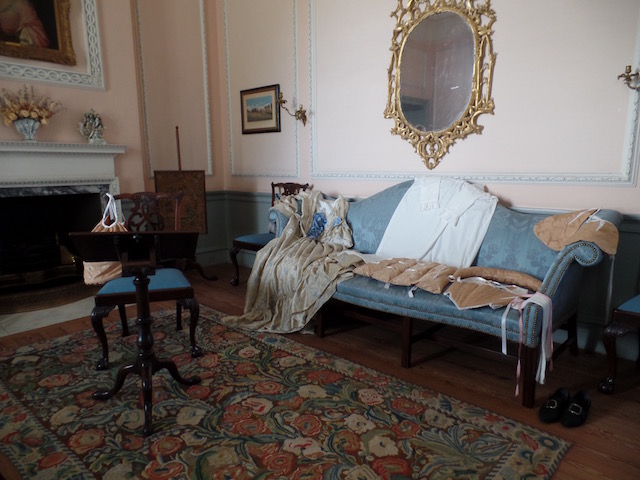
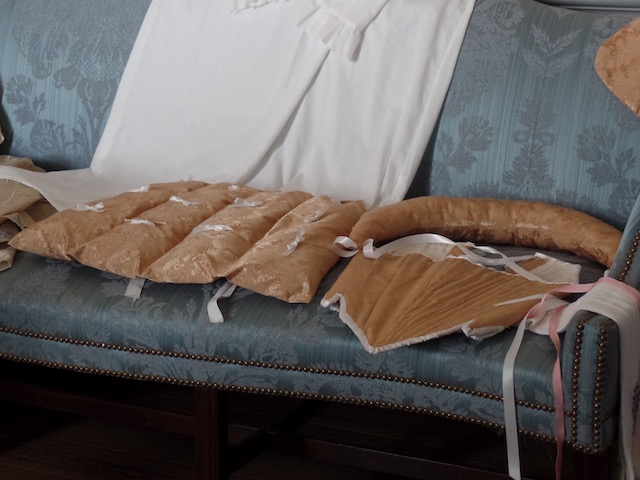
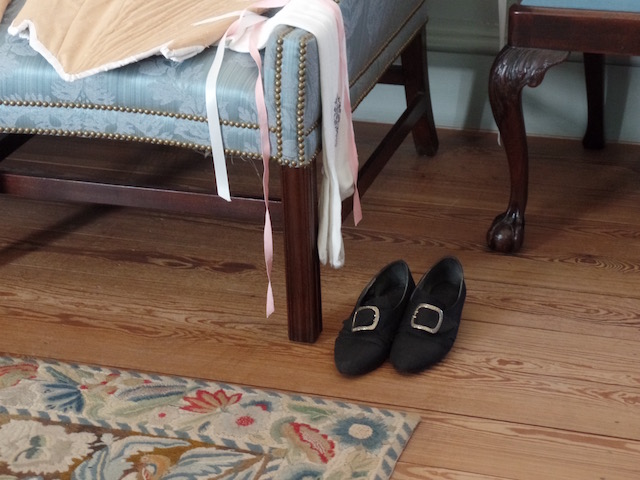
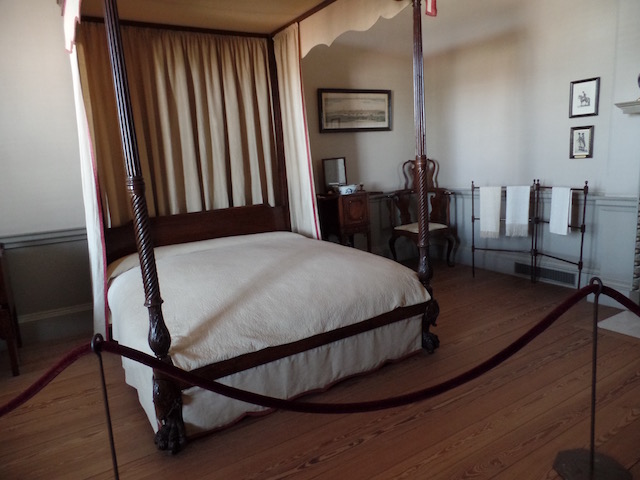
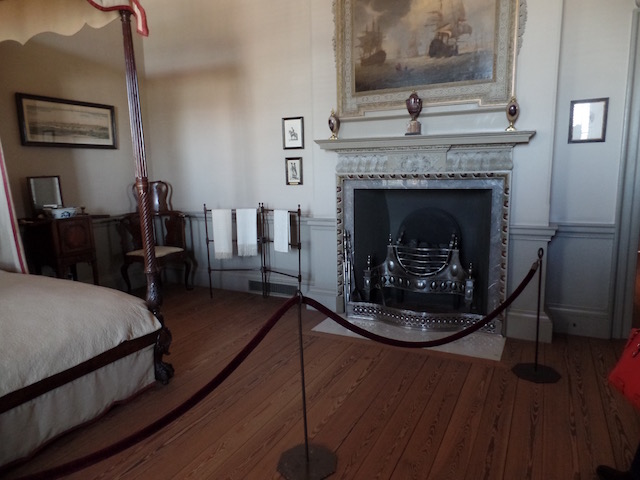
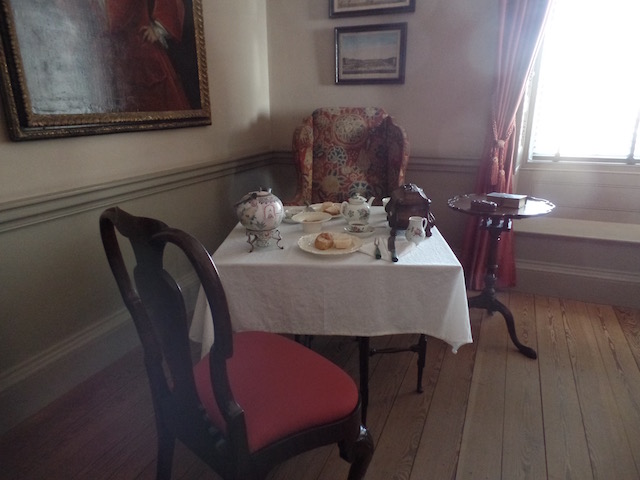
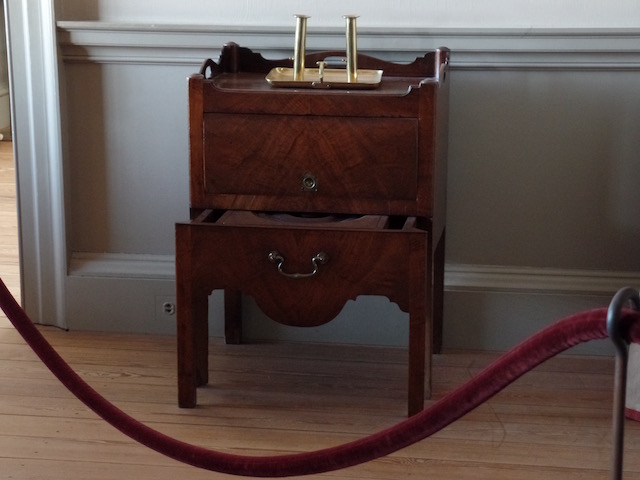
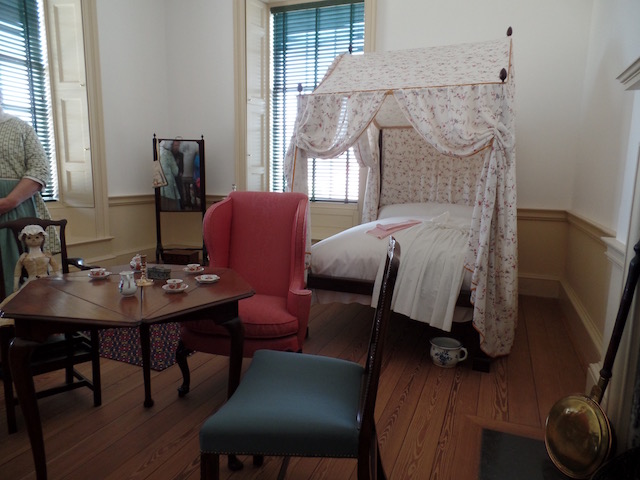
We then headed down the "servant" stairs down to the basement where there were a couple rooms for the servants of the house, as well as storage.
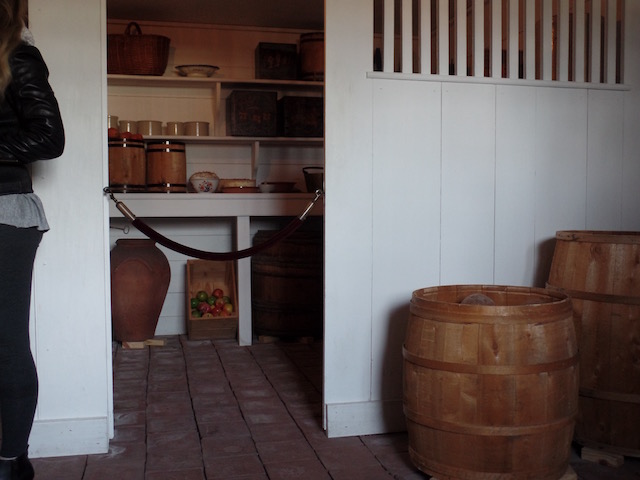
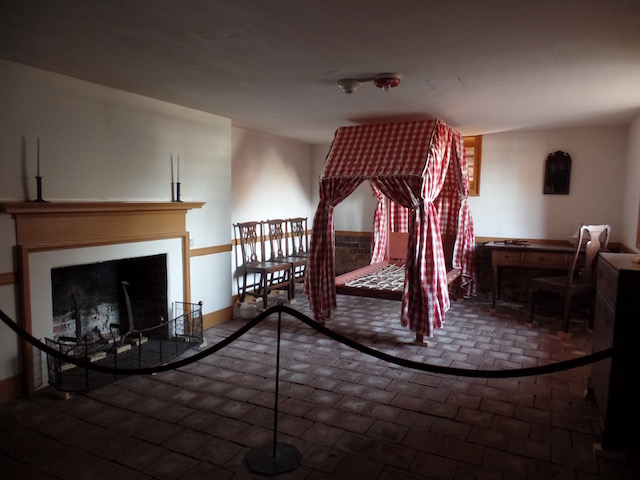
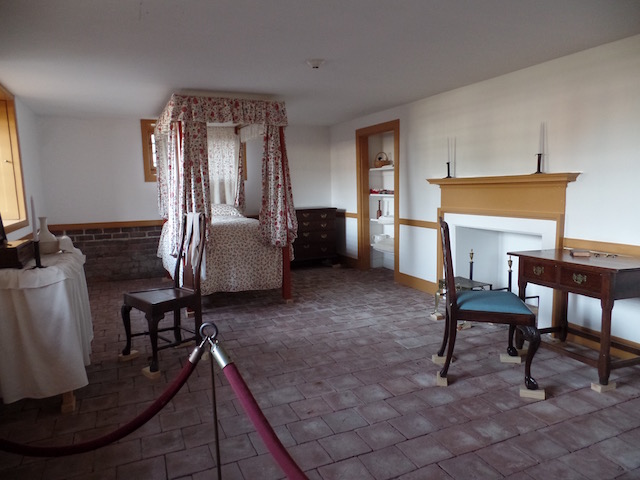
This will show you how cold it was (I believe I used the term "frigid" earlier)! The fountain outside is frozen!
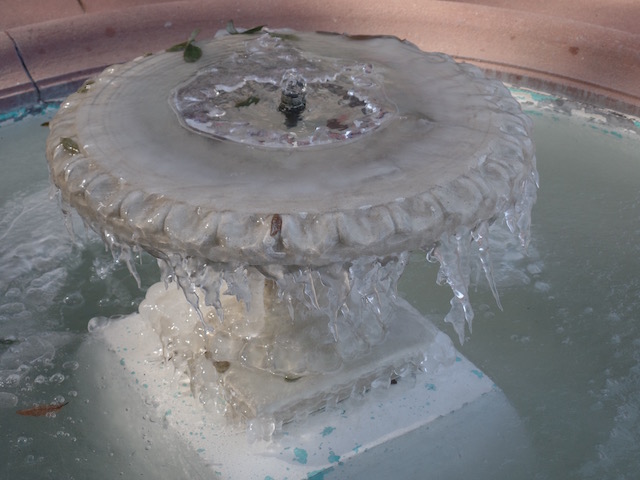
The back of the house isn't all that impressive, but they had really nice gardens. It looked like there were several different areas, including a vegetable/herb garden and something that was much more like a very precise "French" garden.
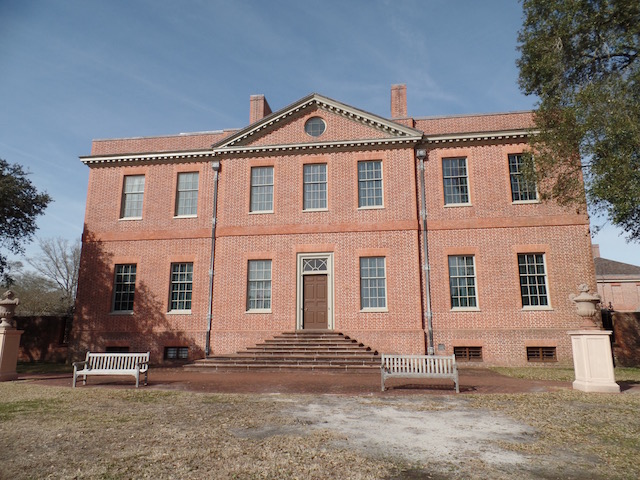
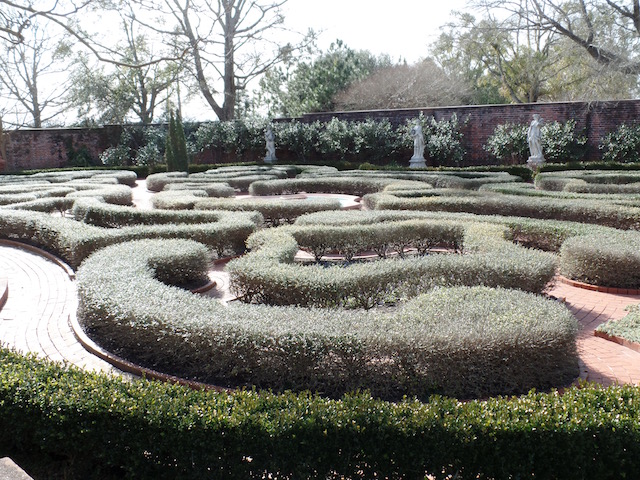
The guided tour tickets included the palace, but also 2 additional houses. The first was the George W. Dixon House. It was built in the early 1830s for Mr. Dixon, a merchant tailor who was briefly a town commissioner. Dixon purchased the lot the house stands on in 1826. It was part of the original Tryon Palace grounds but after the Palace burned in 1798, state divided some of the land into building lots and sold. The Dixon lot represented a choice corner location. The house stands on its original foundation; it has never been moved. the Dixons enjoyed an elegant lifestyle and furnished their home in the latest fashion. But after 1833, Dixon fell on hard times economically. He mortgaged his house and its contents four times between 1833 and 1836, finally losing the house in a foreclosure sale to settle his debts in 1839. Federal in style with some Greek Revival features, the house is a good example of the popular side-hall plan that was popular in New Bern during the early 19th century. Originally two and one-half stories high, the house received a two-story addition at its east elevation by the Stevenson family in the late 19th century.
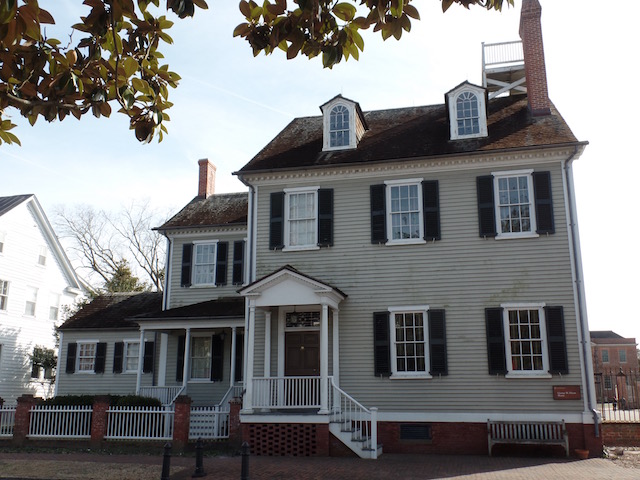
This is a good view of what a side-hall plan was. When you walk into the house, you walk into a wide corridor that goes from front to back. There is a front hall and then an arch, which designates where the "guest" area is and where the "family" area is. Until you were officially invited into the family part of the house, you weren't allowed to pass through this arch. All of the house basically is to one side of this corridor (hence the side-hall name).
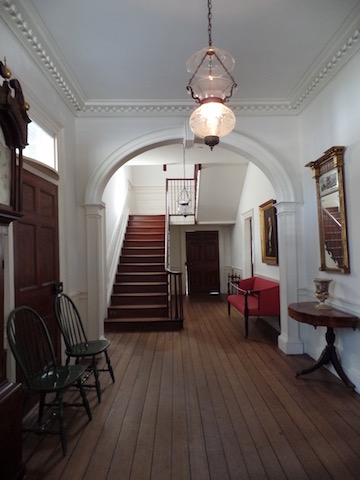
Again, alot of the furnishings are from the right period from when the Dixons would have lived here.
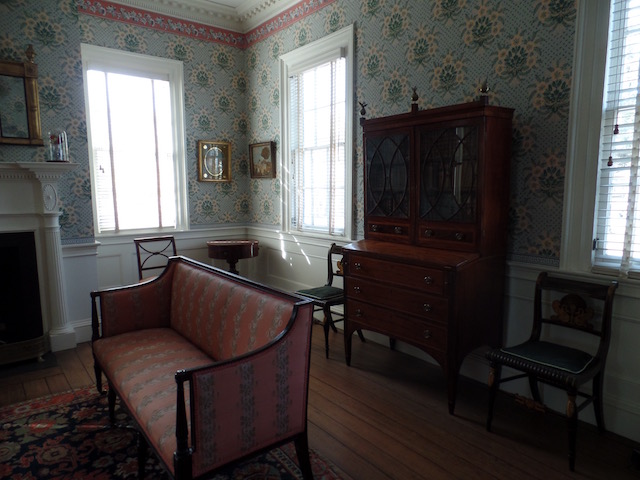
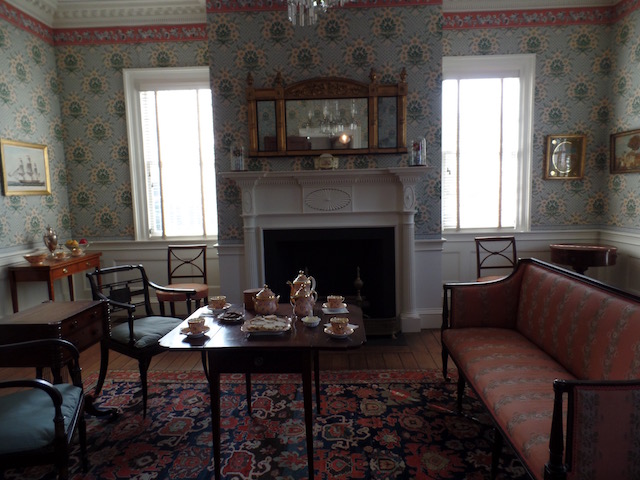
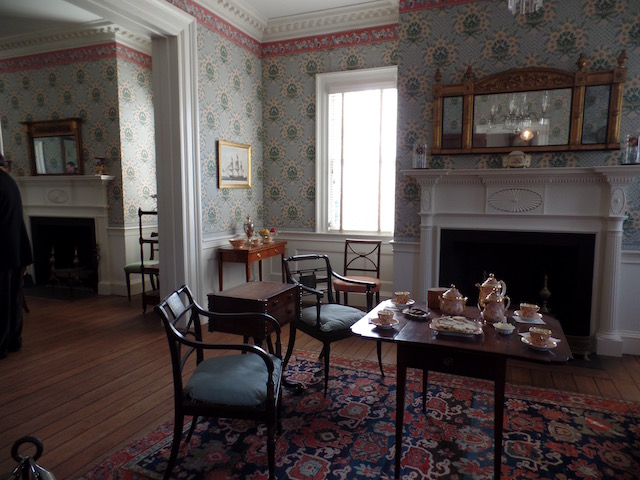
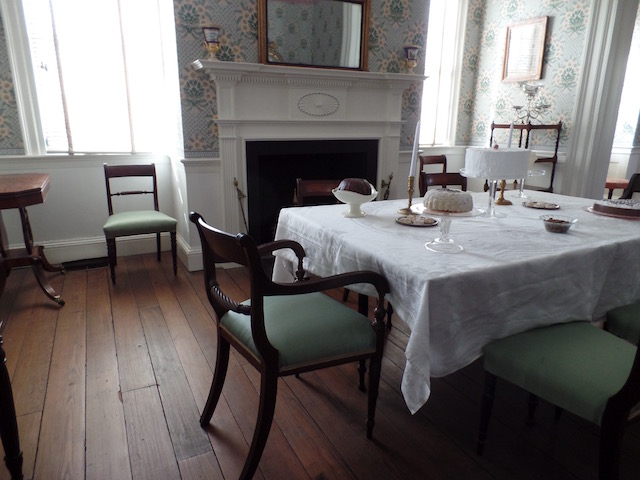
Here is an interesting thing ... to ensure that the windows on the outside (this on the back of the house) were symmetrical, you can see here were the window is basically between floors, with this little bottom part on this floor and the rest of the window in the stairwell.
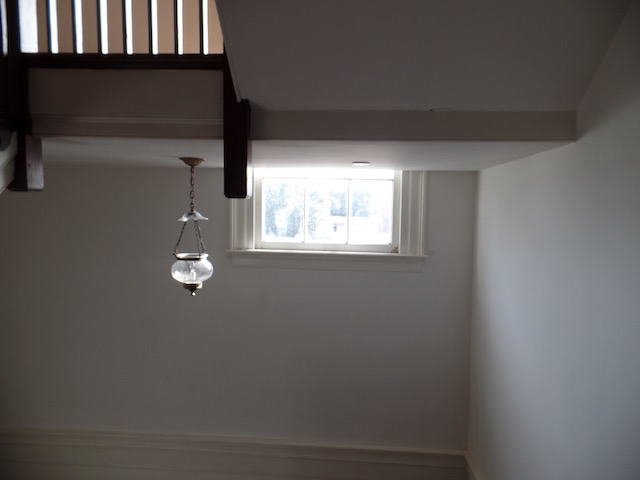
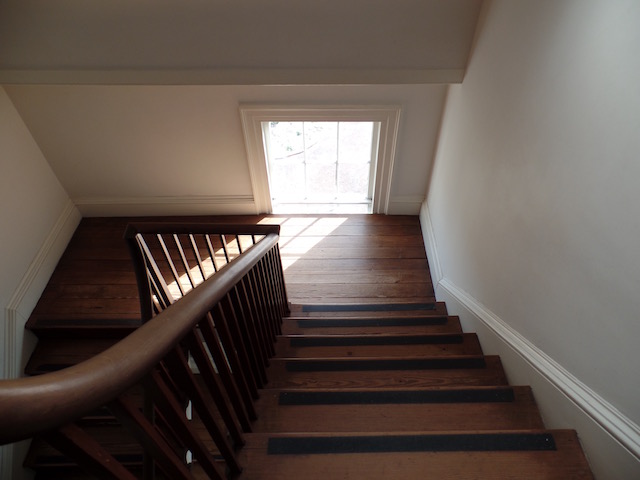
The upstairs has a few bedrooms.
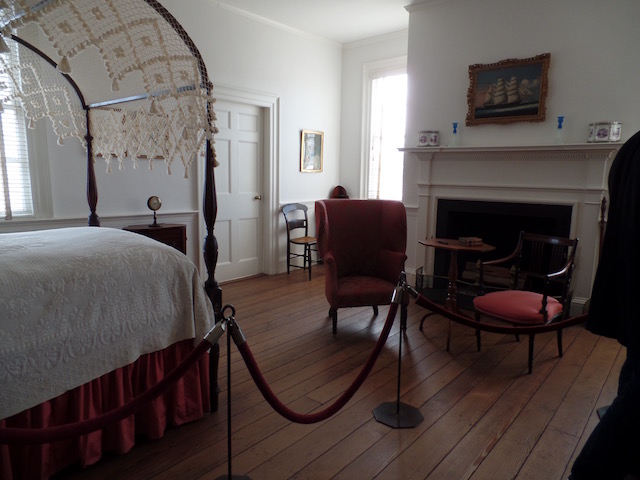
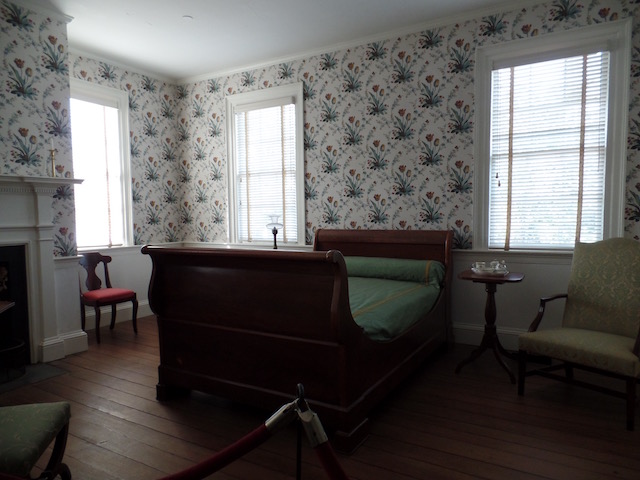
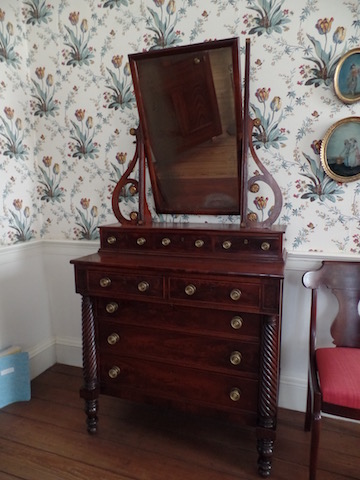
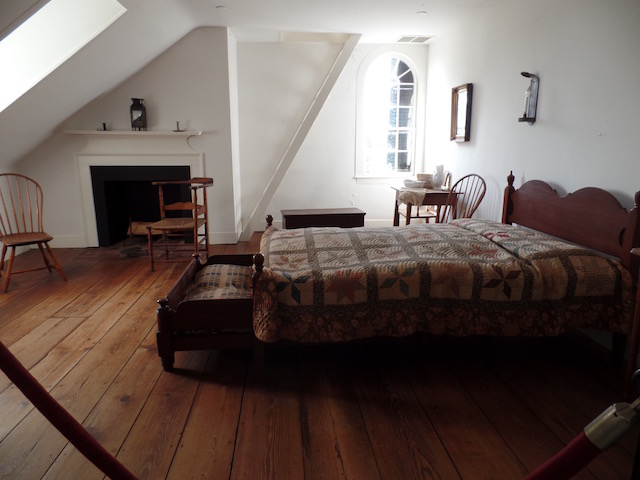
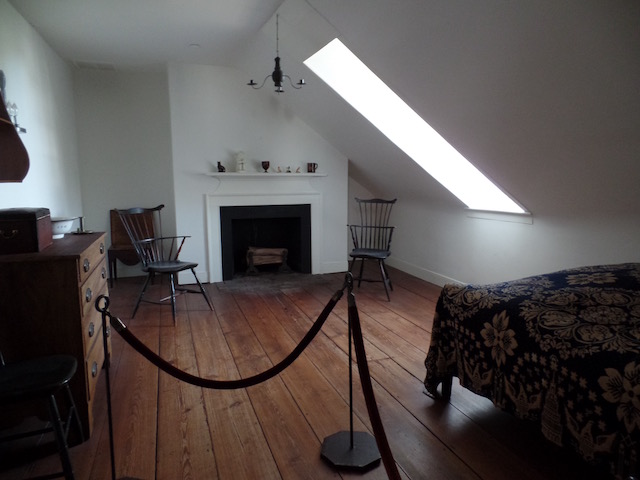
The John Wright Stanly home ...The Stanly House was built in the early 1780s for John Wright Stanly, a prominent New Bern citizen. John Hawks, the architect who designed Tryon Palace, may have designed the Stanly House as well. Built of hand-hewn longleaf pine, the Stanly House remains one of the finest examples of Georgian architecture in the South. While the house has had many owners and uses and has been moved twice, its gracious center-hall plan and grand two-story stairwell are as striking today as they were for 18th-century visitors.
The elegance of the Stanly House reflects the wealth of its owner. Stanly was a powerful businessman whose merchant ships raided British vessels to aid the American cause during the Revolutionary War. John Wright Stanly and his wife, Ann Cogdell, lived in the house only a few years before succumbing to the yellow fever epidemic of 1789. The Stanlys had nine children, the youngest of whom was only three months old at the time of his parents' death. The house remained empty until the eldest son, John Stanly, Jr, came of age and took possession in 1798. The house was empty in April of 1791, when President Washington came through New Bern on his Southern Tour. Legend has it that New Bernians, realizing what a fine house the Stanly home was, opened it up, cleaned it, and put their own furnishings inside for Washington to use. He wrote later in his diary that he had enjoyed 'exceedingly good lodgings'.
John Stanly, Jr, a lawyer and politician, occupied the Stanly home until the mid 1820s. Early in his career, Stanly had political differences with Richard Dobbs Spaight, a former state governor. In 1802, the differences escalated into a duel, and after four rounds, Stanly mortally wounded Spaight. Dueling was illegal and Stanly was forced to leave New Bern until his friend, Judge William Gaston, could convince the governor to grant him a pardon. It was the first gubernatorial pardon ever granted in North Carolina.
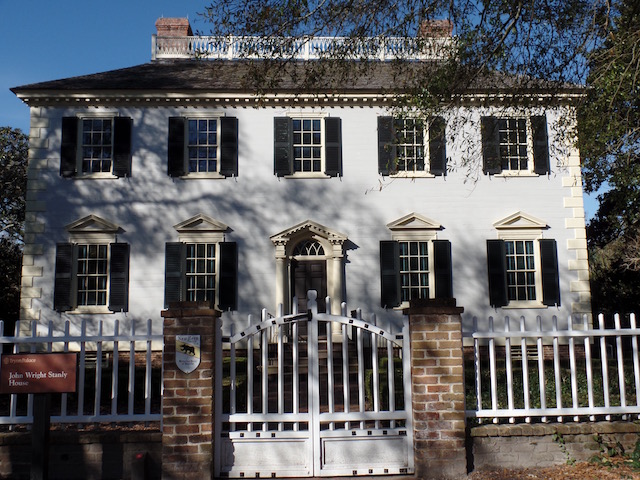
Like the Dixon House, this also has the large main corridor with the arch that separates "guest" from "family" areas. It has a much more grand staircase than the Dixon house, which shows a bit of the difference in wealth and status.
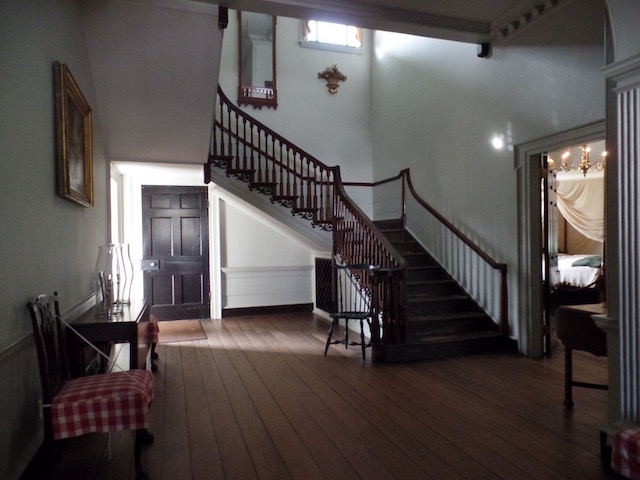
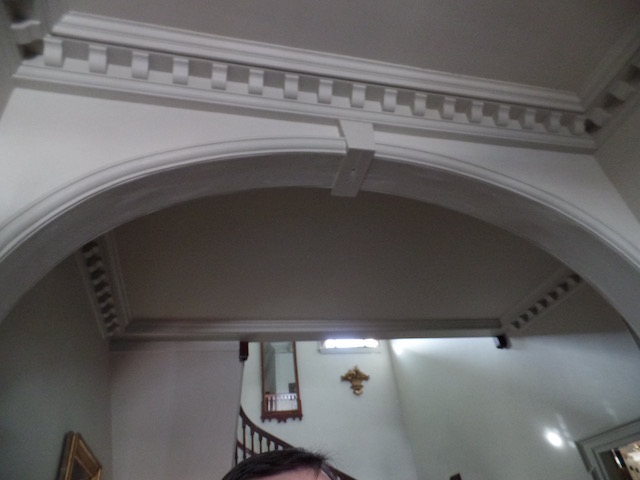
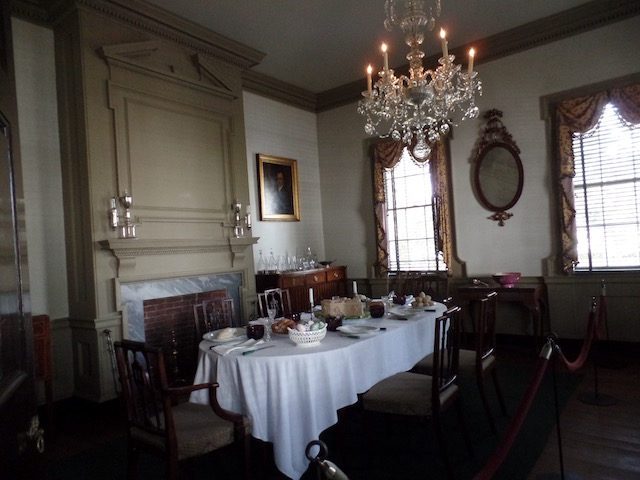
A quick note on this .. there were 2 of these paintings where the painting is actually done on the backside of a piece of glass and then framed.
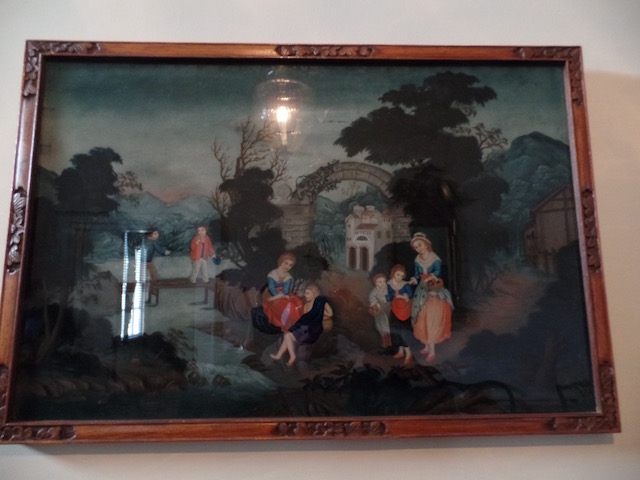
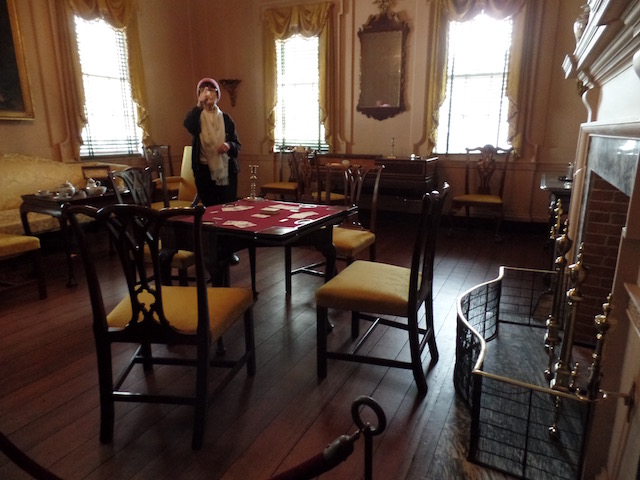
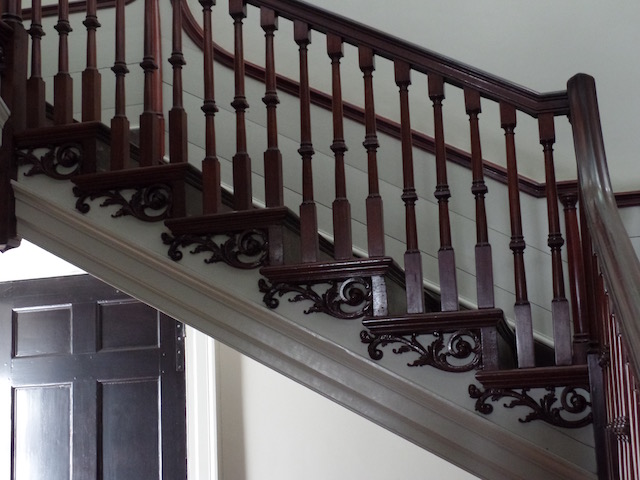
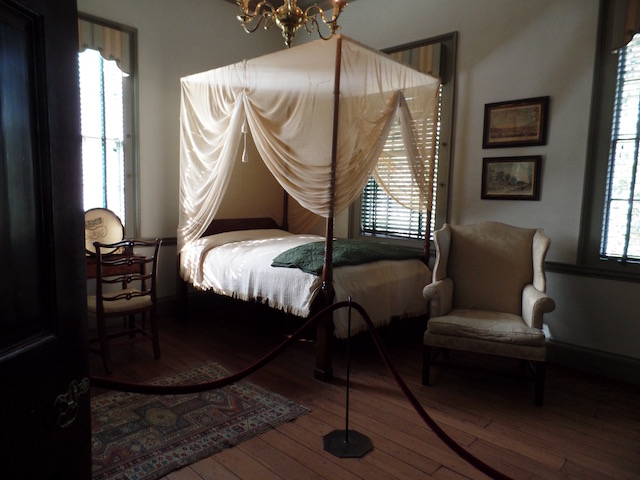
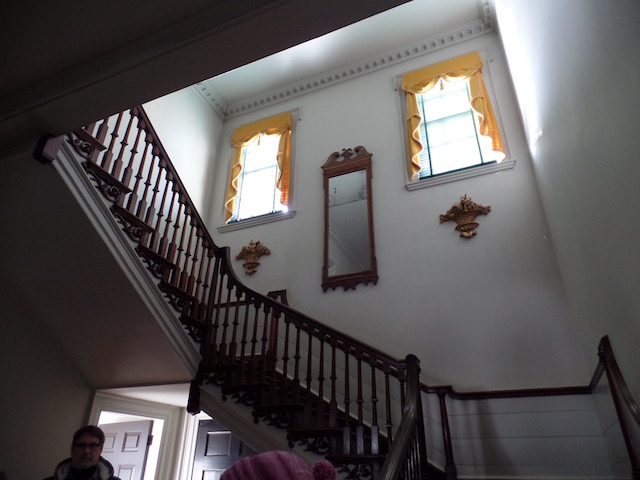
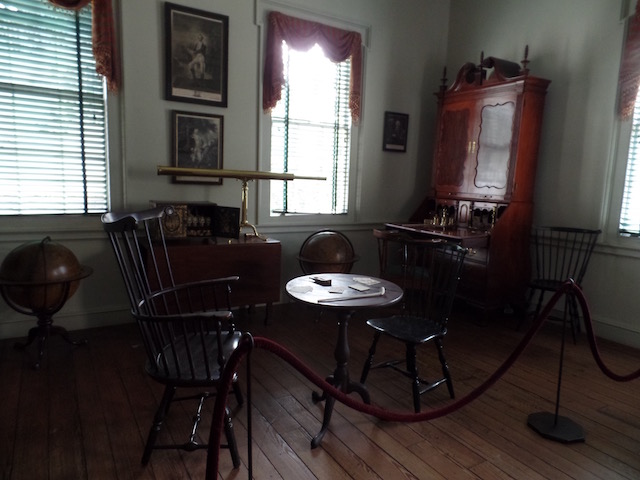
This is upstairs and I really liked the pink light in the middle.
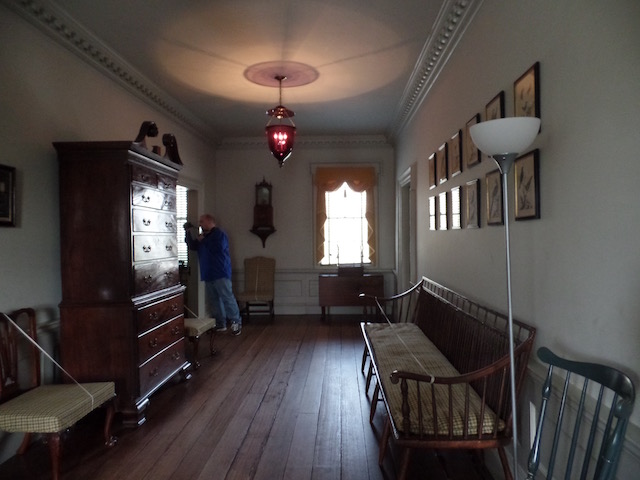
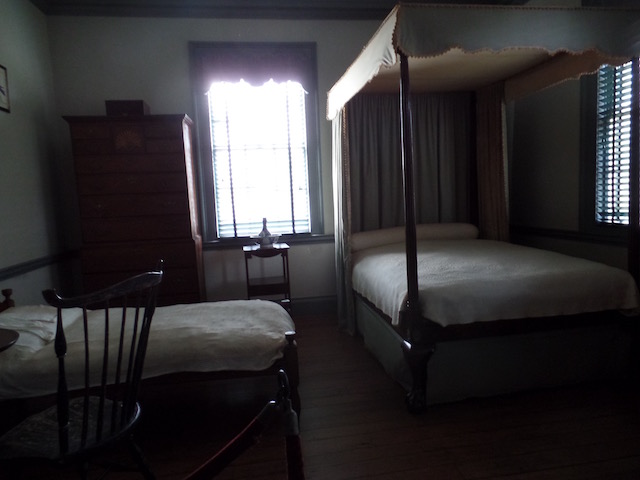
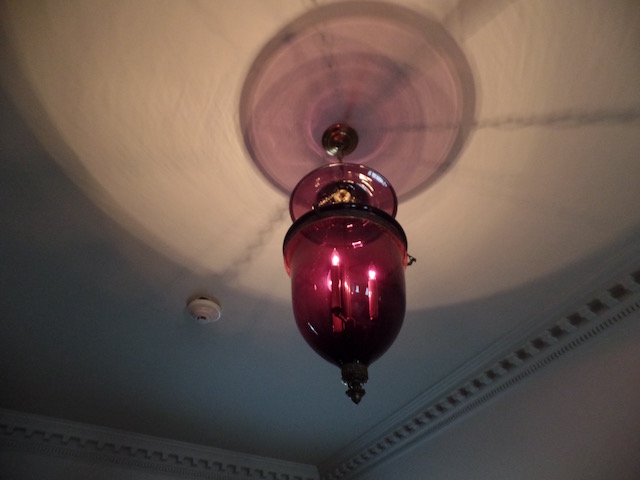
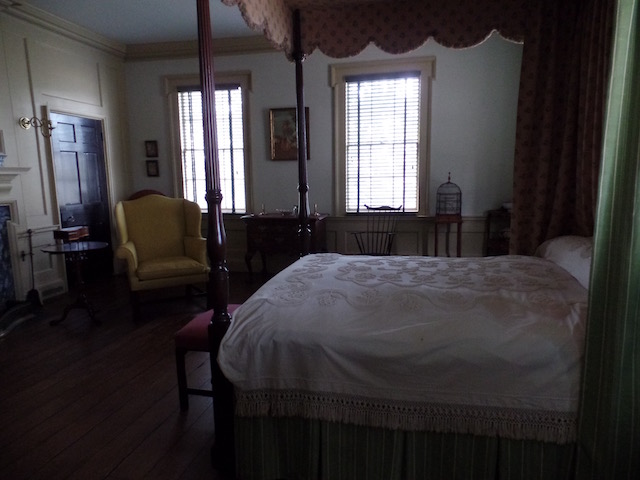
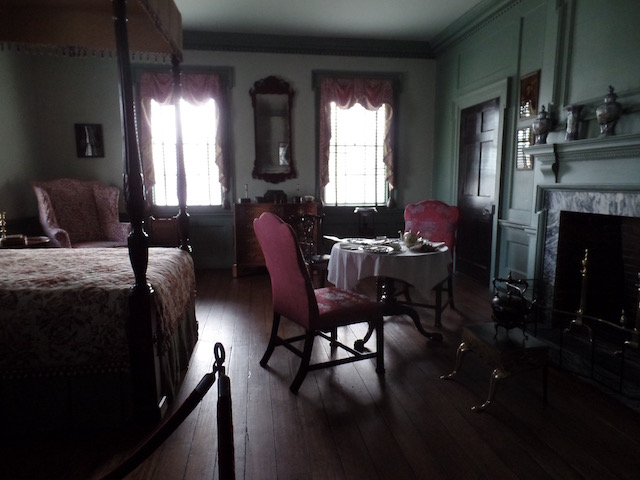
This was a small weaving loom, which almost looks like it would be used to make friendship bracelets :-)
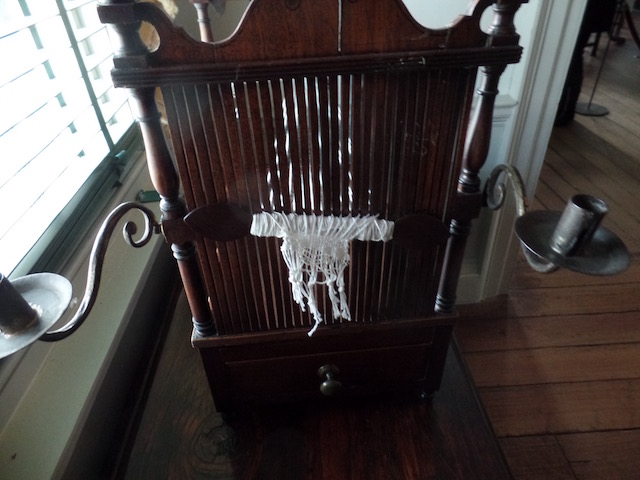
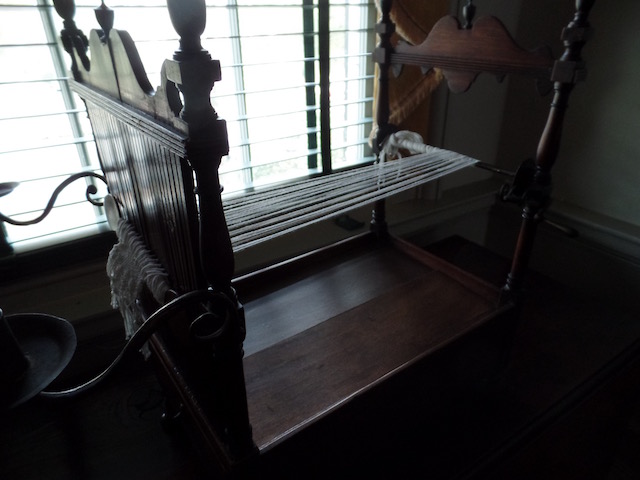
So that ends our tour of the Tryon Palace. It was a bit warmer than the morning and so we headed back out to see more historic buildings. The first was the New Bern Academy, which is actually part of the Tryon Palace itself although located about 4 blocks away. The building dates from 1809 and it was originally a school house for both boys and girls. It served as a hospital in the Civil War and in 1881 became part of the New Bern graded school system which used it for classes until 1971. The New Bern Academy itself was established in March 1764 when the North Carolina legislature authorized the town of New Bern to build a house for a school and residence for the School Master. Work on the new building began in 1765, and by April 1767 it was a very large and handsome school house. When its original frame building was destroyed by fire in 1795, the school was moved to temporary quarters and then the brick building was built in 1809.
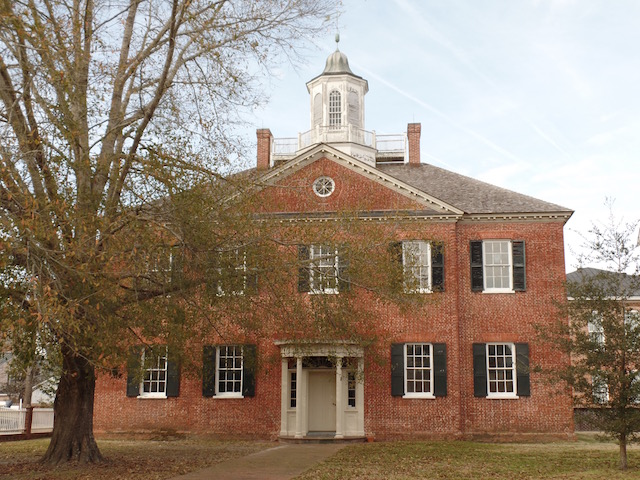
Across the street from the Academy is a Federal-period structure, the Old Methodist Parsonage, dating back to 1810.
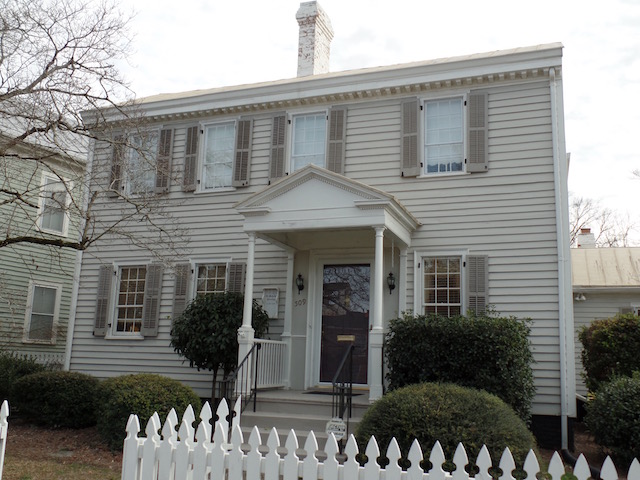
Next is the Cutting-Allen House, circa 1793. This Georgian to Federal-style structure was enlarged in 1856 (a ballroom was added to the rear) and then moved in 1980 to save it from demolition. We think that the original building was just the middle section and the two wings on the sides were added.
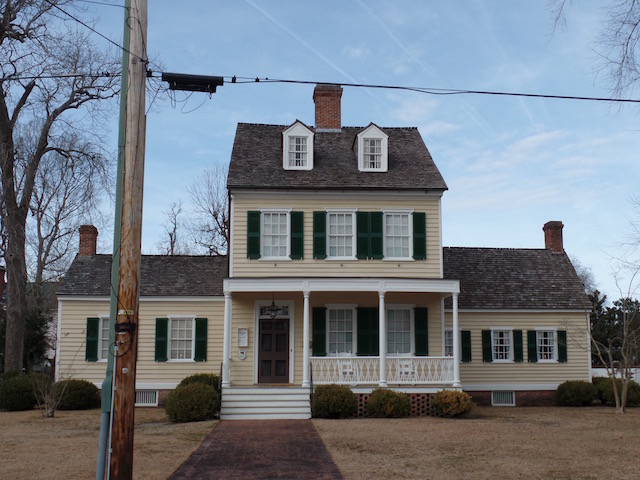
We saw these before, the Hawks House and the Palmer-Tisdale Home.
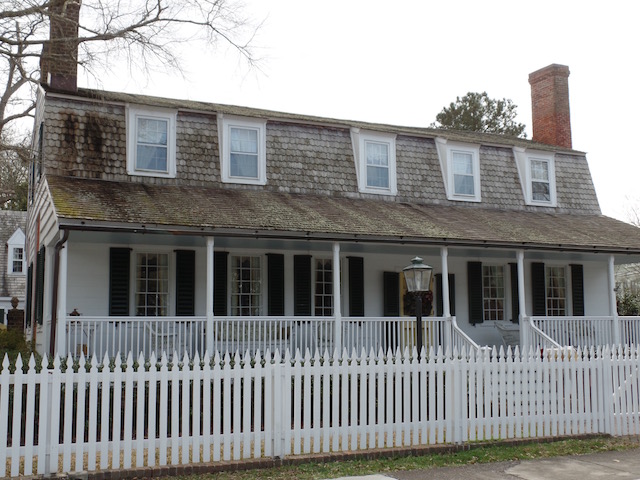
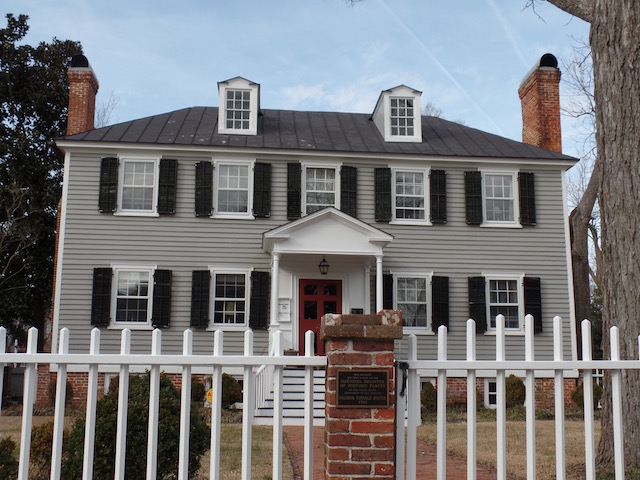
This pretty little blue house is the Clark house, dating back to 1800. This Federal-period house is distinguished from other gambrel roof structures by an uncommon plan and extremely steep roofline.
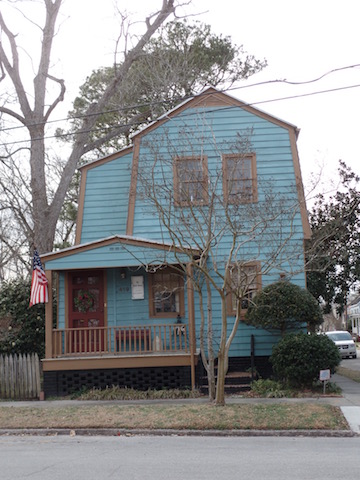
The Jones House dates back to 1914 and combines simple Colonial Revival style with elements of a bungalow. This is one of the best-preserved examples of the four-square form popular in New Bern from 1910-1030.
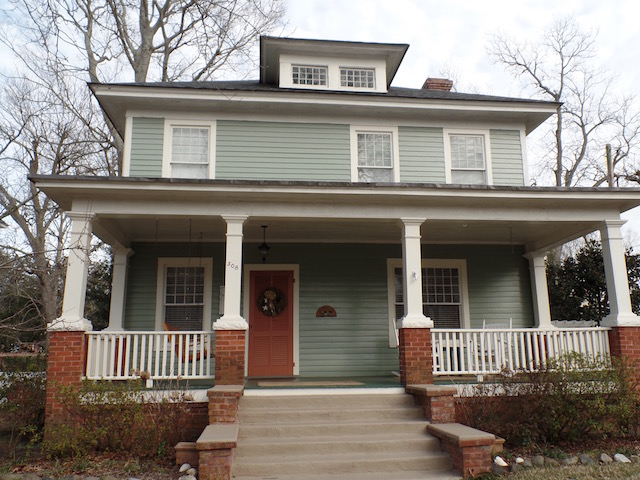
The Smallwood House was built around 1895 for John Smallwood in a gable-front style. You can see a few Victorian details that were added with the wrap-around porch.
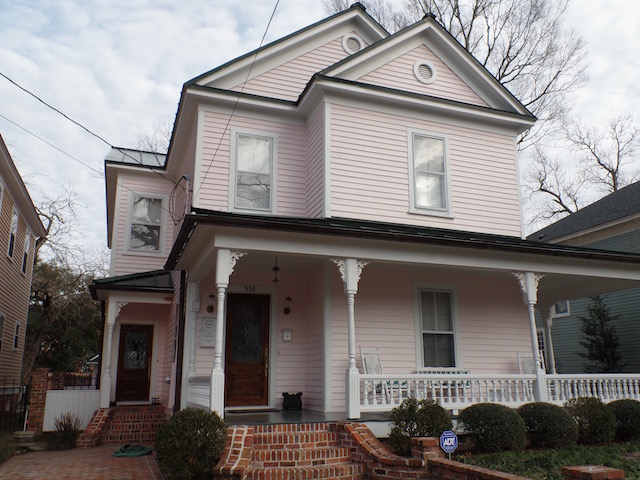
As we headed back toward the cemetery, we passed St. Cyprian's Episcopal Church. It was built between 1910 and 1912 and reflects the continued early 20th century popularity of the Gothic Revival Style.
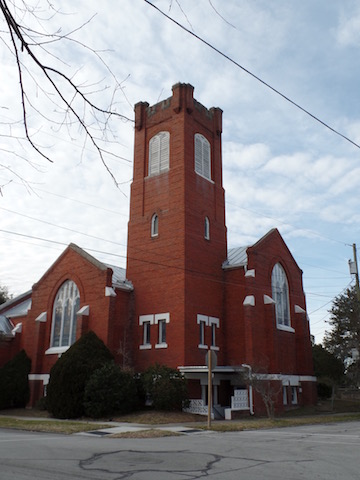
he Battle of New Bern was fought on March 14, 1862, with Brigadier General Ambrose E. Burnside leading the Union attack on the Confederates under General Lawrence O'B. Branch. The Union forces took command of the city which remained under Union control for the rest of the war. The monument sits above a vault where approximately 67 Confederate soldiers are interred who were killed during the war.
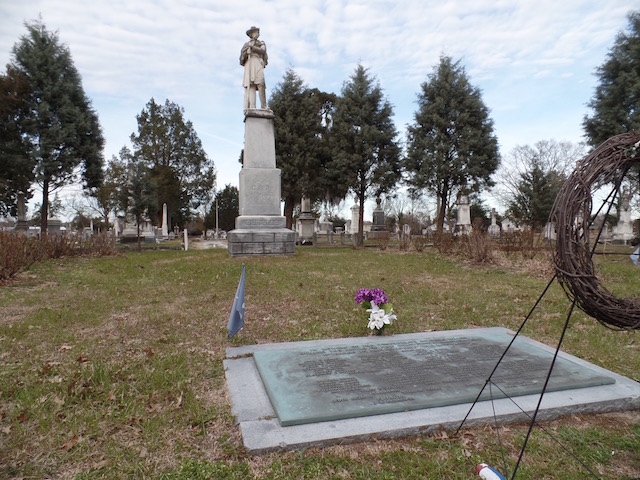
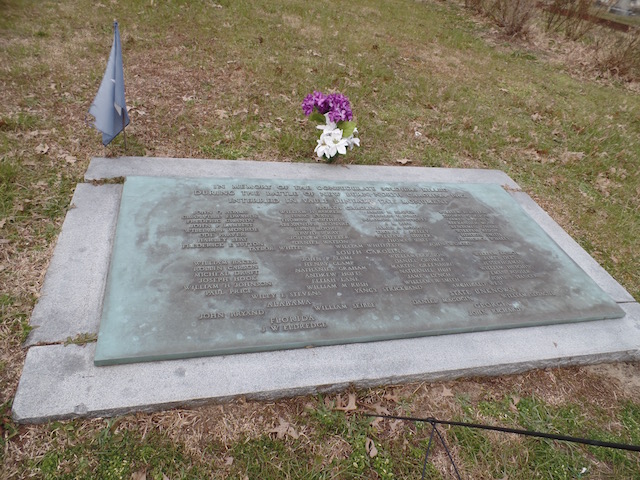
The First Presebyterian Church was first organized in January 1817 and construction on the church began in 1819. It is a magnificant Federal-style building which is similar to New England structures and is one of the only structures like this in the state. The tower has 4 diminishing stages and is one of the finest of New Bern's towers.
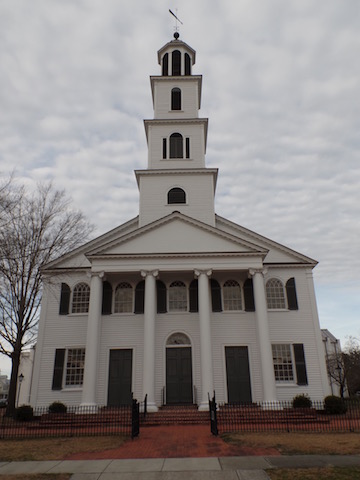
This little church is St. Paul's Roman Catholic Church, which is the oldest Catholic Parish in North Carolina, founded in 1824.
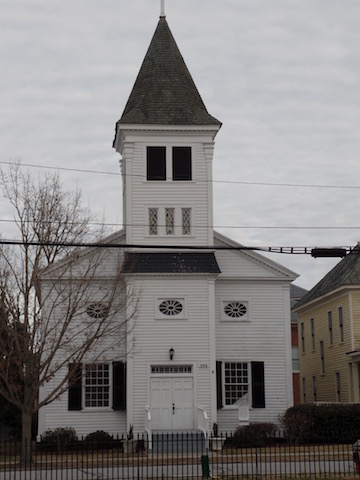
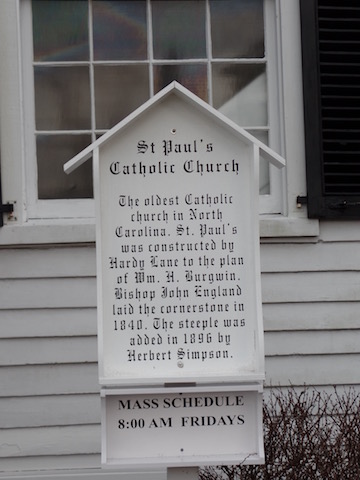
Across from the Catholic Church is the Temple Chester B'nai Sholem Synagogue, which is a Neo-Classical Revival temple that was completed in 1908. The congregation dates back before 1824.
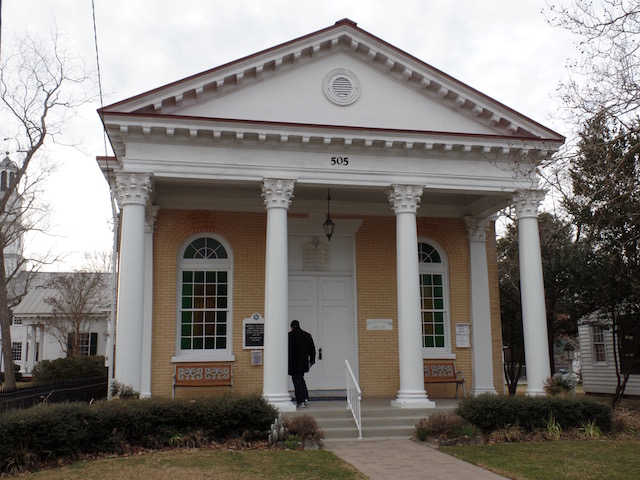
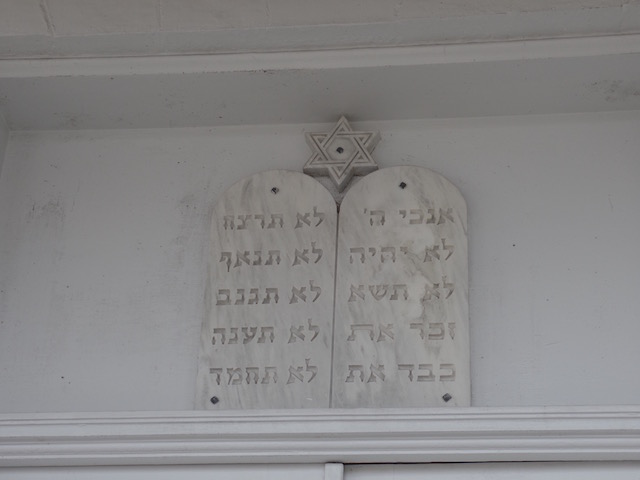
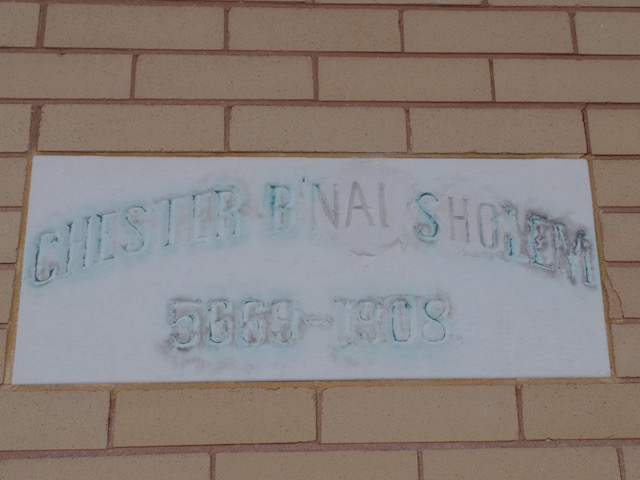
Built in 1904, the Centanary Methodist Church combines Romanesque and Chateauesque styles. Two massive towers flank the impressive main entrance porch.
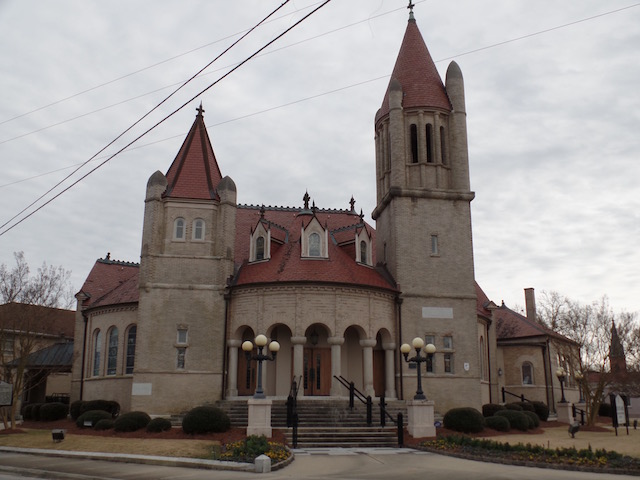
The U.S. Post Office and Courthouse is an excellent example of the Georgian Revival style of architecture. This style is heavily influenced by colonial-era precedents and employs classical ornamentation. The building is three stories and sits atop a granite base. It is clad in red brick veneer that is laid in a common bond pattern. Contrasting limestone trim accentuates the exterior. A central colonnade with six pairs of two-story limestone columns dominates the symmetrical facade. The first level contains five arched entrance openings topped by decorative swag-and-garland motifs executed in limestone. The classically designed entrances have broken pediments surmounted by cast-bronze eagles. A limestone water table encircles the building between the first and second levels. Projecting pavilions articulated by limestone quoins flank the colonnade. Arched windows with classical surrounds span the second and third floors. Classical pilasters support pediments. The same round-arch motif is repeated on two small copper-clad dormers. Double-hung, wood windows are found throughout the building. A parapet with balustrades tops the facade above a dentilled cornice. The steeply pitched roof is covered in slate. A prominent wood cupola with arched windows is capped with a copper roof.
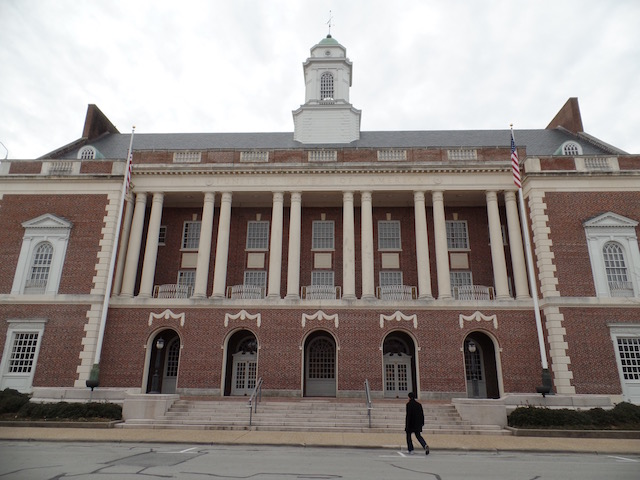
Christian Science started in New Bern in 1894 but this little church, the First Church of Christ, Scientist, was built in 1907. It is a good example of Classical Revival Style.
